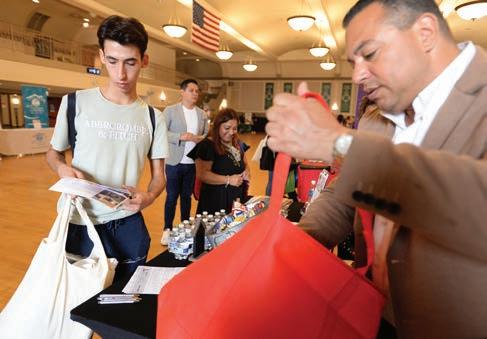



of Oak Park and River Forest









By RISÉ SANDERS-WEIR Contributing Reporter
Cozy Corner, the diner mainstay at the corner of Lake and Marion in Oak Park, will close July 28.
Owners Georgia Dravilas and Peter Gerousis said they are sad to lock the doors on this local institution, but added that they are thankful for the many years and faithful customers.




The restaurant opened 65 years ago with cu rrent coowner Dravilas’ father at the helm. When he was ready to retire around 2015, he made a private sale to a new owner. That person ran into trouble with various government entities as a result of non-payment of taxes, in addition to other financial difficulties.
Because it was a private sale — Dravilas’ father still owned 51% of the business until the purchase loan was paid — the elder Dravilas re gained control of the diner in 2019. Dravilas and Gerousis took over the business shortly after.
The two spent several years resolving the backlog of financial entanglements and then, of course, the pandemic happened.
“If it wasn’t for Takeout 25, we would have been shut
A member of Kuumba Kids Dance wings her way up Ridgeland Avenue dur ing the July 4th Parade. More photos on page 17.


By MARTHA BRENNAN Contributing Reporter
There’s a story behind Fat Cat Art Gallery’s name.
“Yes, the cat really does exist,” said Arturo Reyes, the gallery’s co-owner.
The name, “Fat Cat,” is based of f Mickey, a rescue cat from Houston, Texas. He was rescued from Hurricane Harvey, a Category 4 hurricane that caused $125 billion in damage in 2017, according to The Texas Tribune.
“I think he was traumatized so now he just hoards the food, and I can’t get him on a diet.”
The Gallery held its first exhibit in May. As a means of making the debut special, they assembled a “group exhibition” of five artists from the Chicagoland area: Lisa Giacomino, Holly Hutto, Dominique Maino and Jordan Mummer. Reyes permitted the grand opening to consist of a multitude of different artistic works.
“It went really well,” said Reyes. “We are trying to increase the energy here [on our street].”
intricate art to our community, showcasing both local and international artists who push the boundaries of innovation and self-expression.”
“I’m a child of migrant workers … and my years of working in the fields with my hands plays a big part of my color field journey,” Reyes said. “With 25 years in the art scene, I’ve had the privilege of showing my work in amazing cities like Philadelphia, Houston and Chicago.”
Reyes’ abundance of experiences has allowed him to create a gallery that embraces customers and artists from all walks
welcoming.
“We just have the door open,” she said. “People just come in and out. It’s a really inviting space.”
Even when they are in transitioning periods between exhibitions, D’Landazuri explained that the gallery’s environment stays “professional” with touches of “playfulness.”
“We don’t want to close people of f or have people feel intimidated in any way when submitting work or even coming in here,” she said.
During their exhibits, the artists are usually present. Reyes and D’Landazuri said they believe that they cannot speak for other artists’ drive and meaning behind their creations.

For their next exhibition, ‘Red, Hot, and Blue,’ Reyes had a vision. He wanted artists to interpret ‘Red, Hot, and Blue’ in whichever way sparks their creativity or resonates with their experiences in the United States. The prompt wass open-ended.
Fat Cat Art Gallery’s exhibition ‘Red, Hot, and Blue’ opens July 20.
“People can bring things a little more summery,” he said. “We’re open to color, [such as] red [and] blue.”
“If you wanted to go more political,” said Orianna D’Landazuri, an intern and curator. “We also want to have work that conveys a message.”
The exhibition will take place on July 20 at the g allery.
Reyes co-owns the gallery with Raymond Call. Their mission is to “bring global and
of life, whether a mother who submitted her child’s art piece to be featured in their next exhibition, or a seasoned, experienced artist. The gallery is open to artists of all ages and styles. In addition to featuring a diverse range of artists, Reyes said they strive to make their art accessible and their environment welcoming to all customers.
“We want to make the price points affordable,” Reyes said. “[We] definitely want three price points: your smaller range, your middle range, and then your higher, anchor pieces.”
D’Landazuri described the gallery as
“We can only say, ‘this is acrylic and joint compound from canvas,’” D’Landazuri said. “I can’t tell you what it means or what brought you to drive and create that work.”
Reyes and Call are interested in connecting with the Oak Park community; they have begun contacting local businesses as they look to g et works displayed around town. While nothing has been finalized, they are also interested in a partnership with the Animal Care League to support their cause.
Also, the gallery is in the process of setting up 90-minute art classes for the public. They will offer both Zendoodle, which is used for meditation, and watercolor classes, charging $95 for one or $280 for four.
“We don’t want just experienced artists,” said D’Landazuri. “[We want] beginner artists, even group classes [where] people are just looking to have fun.”
The Fat Cat team is interested in “building a bridge” with artists in the entire Chicagoland area. They also emphasize their appreciation of art collectors, both small and large.
“We hope to court collectors and people who appreciate the art, and not just the big [pieces].”
For more information, visit https:// www.fatcatar tgallery.com.
WEDNESD AY
of Oak Park and River Forest
Editor Erika Hobbs
Digital Manager Stac y Coleman
Sta Reporters Amaris E. Rodriguez, Luzane Draughon
Viewpoints Editor Ken Trainor
Real Estate Editor Lacey Sikora
Digital Media Coordinator Brooke Duncan
Columnists Marc Bleso , Jack Crowe, Mary Kay O’Grady, Kwame Salter, John Stanger
Shrubtown Cartoonist Marc Stopeck
Design/Production Manager Andrew Mead
Editorial Design Manager Javier Govea
Designers Susan McKelvey, Vanessa Garza
Marketing Representatives
Lourdes Nicholls, Ben Stumpe
Business & Development Manager Mary Ellen Nelligan
Circulation Manager Jill Wagner
Special Projects Manager Susan Walker
Chairman Emeritus Robert K. Downs
Publisher Dan Haley


July 12, 7:30 p.m., Madison Street Theater
A stand-up comedy show where everyone can see themselves. Connect and laugh alongside a lineup of comedians sharing their crazy life experiences. General .m. Purchase .com/ykb2963y, 1010 Madison
Saturday, July 13, 9:30 a.m. - 12 p.m., Rush Oak Park Hospital - Centennial Room Join persons with Parkinson’s Disease and other move ment disorders in a monthly support group meeting. Neurologist Jori Fleisher, MD, MS, will discuss tips and tricks for living with PD and various disorders. Patients and caregivers are encouraged to come in person, but the meeting is also available virtually. 520 S. Maple, 2nd oor, Oak Park


Friday, July 12, 6:30 – 8:30 p.m., Host Home: 159 N. Taylor, Oak Park
Featuring: The Bart Attacks / The Staleys Free Event: Bring your own chairs and blanket.

Thursday, Sept. 12, 6:30 – 9:30 p.m.,
Friendly Community Gallery
Please join us for an exhibition of paintings by Jill Jeannides (1975 – 2021), from Sept. 12 – Oct. 6, at the Friendly Community Galler y in Berw yn. Jeannides, an alumnus of The School of the Art Institute of Chicago (SAIC) and a Lake Forest native of Ukrainian heritage, died unexpectedly in 2021, leaving behind a large, captivating collection of ar tworks now managed by her family. 6729 Roosevelt Road, Berw yn
- Tacos Bernardo will be there
- Tip jar will be passed to support the bands
- For more information and updates, follow us on Facebook at Oak Park Porchfest
Tuesday, July 16, 3:30 – 4:30 p.m., River Forest Public Library - Barbara Hall Meeting Room
Bring your old T-shir t and turn it into a tote. Don’t have a T-shirt you can spare? We will have ex tras. Advance registration required. Grades 5-12. Register at https:// tinyurl.com/3xf5n2tv, 735 Lathrop Ave., Oak Park
Friday, July 19, 1 – 3:30 p.m., River Forest Public Library - Barbara Hall Meeting Room
Join other movie lovers on the third Friday of every month to watch classic lms. This summer, we’re paying tribute to the king of summer blockbusters, Steven Spielberg. Today we’ll be watching Raiders of the Lost Ark (1981), the rst (and, according to many fans, the best) lm in the Indiana Jones series. Stick around for a post- lm discussion led by local movie expert Jim Jacob. Snacks will be provided. Brought to you in partnership with the River Forest Township. Register at https:// tinyurl.com/2s3a95zv, 735 Lathrop Ave., Oak Park
Saturday, July 20, 11 – 11:30 a.m., Oak Park Public Library - Storytime Room
Babies learn to associate books with fun and shared moments with favorite adults during this storytime, designed for one-on- one interac tions between caregivers and children, bir th to 24 months. One-year-olds love to wander and listen while they explore, and caregivers can help them participate while on the move. Short books are paired with songs and rhymes that are modeled to introduce pre-literacy skills. 834 Lake St., Oak Park
Soup & Bread Community Fundraiser Meal to raise funds for Sarah’s Inn
Tuesday, July 16 , 6 - 9 p.m., Rober t’s Westside
Come out and enjoy a meal of hear ty soups, bread and desserts provided by local community chefs from Oak Park, River Forest & Forest Park, while listening to the tunes of the Szurko Trio and raising funds for Sarah’s Inn. Pay what you will at the door. We will also be collecting school supplies for Sarah’s Inn back-to-school drive. 7327 Madison, Forest Park
Wednesday Jour nal welcomes notices about events that Oak Park and River Forest groups and businesses are planning. We’ ll work to get the word out if you let us know what’s happening by noon Wednesday a week before your news needs to be in the newspaper.
■ Email details to calendar@wjinc.com

from page 1
down back then,” Gerousis said. “We cannot be any more grateful. I almost feel like we owe the community a debt.”
In the past two years, the owners finally felt they were back on solid financial footing and the restaurant was thriving. The next challenge that loomed before them was the end of a 30-year lease for the space at 138 N. Marion St.
According to Gerousis, the landlord infor med them that their rent would more than double for the restaurant space. So last November, the owners began a search to see whether a good option existed to move to a new location.
They thought they had found a perfect situation in the for mer Bar Louie spot at 1122 Lake St., less than a block away.
“It was almost four times larger than what we have here. It was a little bit bigger than what we wanted, but we definitely could make it work,” Gerousis said.
There were other advantages, too. They hoped to build out the new space while still being able to operate out of the old one, making it an almost seamless move across the street. Not having a gap in time mattered to the employees, as well.
“The whole purpose of moving there is to have keep my team with me. I can’t ex-
pect employees to wait like three months for us to g et that ready,” Dravilas said.
The for mer Bar Louie space was involved in court proceedings, so lease ne gotiations moved slowly. Four months passed. Then it fell through. According to Gerousis, a new investor in the commercial property came into the picture and refused to give them more than 10 years on a lease. Cozy Corner’s owners said it would be hard to get a loan for renovations without having an option to extend past 10 years.
“We just kind of ran out of time,” Gerousis said.
So Dravilas and Gerousis made the heartbreaking decision to close Cozy Corner. They informed the staf f first.
“We wanted to give them as much notice as possible,” Gerousis said. They are working to help staf f find positions in other local restaurants.
Both owners said they are grateful to have been a part of the fabric of the area.
“Cozy Corner would have never been a success, if it wasn’t for this community,” Gerousis said.
Dravilas has one more request for the community: “If you come in before we close, please be generous to the staf f. They are the heart of Cozy Corner.”
While you still can
Website: cozycorneroakpark.com
Hours: Every day 7 a.m. – 3 p.m.
Location: 138 N. Marion




Obser ving National Minority Mental Health Awareness Month ‘breaks down barriers,’ o cials say
By HECTOR CERVANTES
Contributing Reporter
July marks National Minority Mental Health Awareness Month and aims to spotlight the distinct mental health challenges encountered by racial and ethnic minorities in the United States, while advocating for strategies to dismantle barriers and combat stigma.
The Community Mental Health Board of
Oak Park Township is one of the resources in the community that recognizes this month and provides resources and treatment.
This b oard acts as a f under, suppo rting mental health, substance use and developmental disability services for Oak Pa rk r esidents. A dditionall y, the b oar d performs needs assessments for the loc al community
“What we do is identify the specific needs of Oak Park residents and help to fund programs that eliminate barriers to care,” said Community Mental Health Board Executive Cheryl Potts.
Potts said that National Minority Mental Health Awareness Month is significant because minorities have the same rates of diagnosis of mental health disorders as non-Hispanic whites, typically around 20%

to 25% of all populations.
“The biggest issue is access to treatment, engagement, and care Approximately half of white individuals seek treatment, which is still very low, but this rate drops substantially for other minorities: 40% for Black individuals, 35% for Latinx individuals, and 25% for Asian communities,” Potts said.
Potts has more than 25 years of experience in the human services field. As a resident of Oak Park and someone living with
a mental health disorder, Potts has personally faced the challenges they aim to alleviate for their neighbors. With a family history of mental illness and addiction, Potts experienced a tragic loss when her brother died by suicide in 1999.
“To me, mental health is not just my work; it is my life’s passion. I believe lives can be saved when people have the information and the ability to seek care because recovery is possible. Unfortunately, my
5.30%

brother did not get to achieve it, but I am able to live in recovery,” Potts said.
Potts emphasized that representation matters. She explained that the purpose of this awareness month is to begin dismantling the stigma surrounding mental health and to acknowledge that mental health support is necessary for all demographics
According to Potts, these disparities are deeply concer ning for community workers as individuals who receive care and treatment experience significantly better life outcomes. Recovery is both achievable and rewarding, yet many people endure their struggles in silence rather than seeking help.
“Minorities face distinct challenges compared to white individuals, such as lack of insurance, inability to af ford care, and being uninsured or underinsured, with these issues being especially prevalent in Black and Brown communities,” Potts said.
Stigma and cultural competency barriers also are significant issues because mental health providers tend to be white and female, which can be a barrier for individuals from Black or Latino communities who have unique cultural experiences affecting their mental health.
“One significant issue we’re encountering is an increase in overdoses, affecting both the West Side of Chicago and nearby west suburbs,” Potts said. “The West Side Opioid Task Force addresses opioid-related problems, but in Oak Park, we also focus on other substances, including those laced with fentanyl. Additionally, there is a shortage of Adderall and ADHD medication.
“My niece overdosed seven times, but has thankfully been sober for four years. Often, people view the opioid epidemic and overdoses as distant issues, but these crises impact our families directly. We are grateful for organizations like Live4Lali, which helped save her life when she was ready for recovery,” Potts said.
“Minority communities face higher rates
Potts outlined her long-term goals for improving mental health among minority communities in Oak Park Township. She emphasized the importance of increasing the number of people engaged in treatment and receiving care
mental health services.”
CHERYL POTT S Community Mental Health Board executive
“These individuals may not connect with a white woman sitting on the other side of the table. Representation matters, and the purpose of National Minority Mental Health Awareness Month is to start breaking down this stigma and recognize that mental health support extends beyond just one demographic,” Potts said.
To better understand and address the mental health needs of the community, the Community Health Board performs a needs assessment every three years.
“The data reveals that minority populations are not participating in care at the same rates as white individuals. To address this, we fund several programs that focus on early intervention, particularly targeting youth and young adults to highlight the importance of mental health and reduce the stigma associated with self-care,” Potts said.
Some of these programs the board collaborates with is Youth Educational Mentoring Basketball Association and the board also fund programs on the treatment side, including the National Alliance on Mental Illness for peer networks and engagement.
The board collaborates with partners who provide valuable services twice a week, maintaining strong connections with them.
“The objective is to eliminate barriers to care, many of which stem from racist systems and structures. Minority communities face higher rates of intergenerational trauma, which complicates access to mental health services,” Potts said. For instance, new immigrants, such as Venezuelans, experience increased trauma, requiring a culturally responsive approach. Recognizing that one solution does not fit all.”
Potts stressed the need to understand and address individual needs through treatment, medication, or other appropriate services, and to facilitate easier access to these resources.
Potts added that the most crucial action people can take is to keep discussing mental health, removing its stigma and making it a re gular part of daily life.
“Just as people talk about physical health, what they eat, and how much water they drink, we should nor malize conversations about mental health. This can help ease individuals into seeking care and alleviate their concerns,” Potts said.
Engaging in genuine and profound conversations about mental health is essential. Potts believes that sharing personal stories holds significant importance, as others need to hear them. Potts said that increased dialogue about mental health helps to normalize the topic, making it easier for individuals to seek and receive care

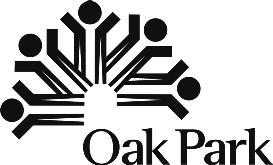






Band per forms at the 2023 Southtown Summer Fest in Oak Park.

Sponsored Content
By LUZANE DRAUGHON Staff Reporter
Oak Park’s second annual Southtown Summer Fest will be from noon to 4 p.m. July
hen I started dating my husband Mike, I did not know that he would introduce me to the nicest and happiest guy I will likely ever meet. That guy is his dad, my father-in-law, Bill Clancy. Despite Bill growing up with a lot of hardship in his life, he only has good things to say about his childhood. His father died when he was six, so for several years he was raised by a single mother. During his childhood, money was tight. As a 10-year-old, Bill would wake up before dawn and help his milkman adult brother deliver milk before school. Exhausted, Bill would often fall asleep in class. In telling that story, Bill would just laugh; he had no resentment.
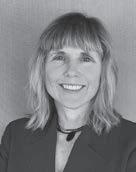
focusing on all the good around us?
Researchers have found that humans have a negativity bias. That is -- a bias to pay more attention to negative information than positive. We respond more quickly and with more intensity to negative events. This is why we remember insults more than compliments and ruminate on small negative things rather than see all the positives.
Negativity bias is thought to be an adaptive evolutionary function. Thousands of years ago, our ancestors were exposed to immediate environmental threats like predators. Bias for the negative information helped keep them alive.
father-in-law Bill Clancy, who can overcome their negativity are not only happier people, but we live longer.
How do we overcome our negativity bias? We need to direct more of our attention toward positive events and feelings than negative ones. Throughout the day check in with yourself and your thoughts. Identify thoughts as helpful or unhelpful. Once you notice the unhelpful or negative thinking, you can investigate its source. Are you tired, lonely, hungry, disappointed, embarrassed or something else?
13 on Van Buren Street on both sides of Oak Park Avenue
T he c ommunity event, a ccording to Vi llage Manager Kevin Jackson’s weekly re po rt , will feature activities including live musi c, g ames, face-painting and a d unk tank.
North Gr ove Band and Francis Bassett-Dilley T rio will entertain a ttendees with live performances. North Gr ove Band pl ay s indie or f unk-style musi c, wh i le Francis Bassett-Dilley T rio pe rfor ms jazz.
Festival-goers might also be i nterested in shopping at the event’s artisan market, where all proceeds go to the artist. Loca l foodies may be excited about the o ppo rtunity to taste dishes from restaurants in the S outhtown Business District, wh ich will be available at the f estival. Kettlestrings Tave rn , A ddis Cafe and Marga ritas are part icipating.
Bill, his mother, his adult sister and his sister’s family rented an apartment together above a tavern. Each family was responsible for paying a utility bill. Sometimes, the family responsible for the electricity bill could not pay it. So, the lights were shut off. On those nights, the tavern’s neon sign was the only light to be seen. When asked about that hard time, Bill said it was great because that purple neon light made everything in the apartment look so beautiful. Bill Clancy is a nice, happy-go-lucky guy who recently celebrated his 94th birthday. Many of us do not have the positive life outlook that Bill Clancy does. In fact, some of us can in one day have one negative experience and ten positive experiences, and all we remember is that one negative experience. Why is that? And why are we so attracted to negative news stories or dwell on unpleasant traumatic events instead of
In modern times, adults don’t need to rely on negative bias to keep us safe. Unfortunately, those hardwired tendencies run deep. The brain is like Velcro for negative experiences and Teflon for positive ones. Plus, negativity bias is linked to loss aversion, a cognitive bias that makes the pain of loss much more powerful than the pleasure of gain.
Studies have found that when participants viewed negative images, there was a much stronger response than positive images. Negative emotions last longer than positive ones, and we spend more time thinking about negative events. This is likely related to learning and memory processes. The more attention we give to a stimulus or experience, the higher the likelihood that we will commit it to memory. Sadly, negativity bias has a direct impact on our relationships, popular culture, and our lifestyle.
So can we outsmart our biology? Yes, we can, and we should! Those of us, like my
Start to replace the unhelpful thoughts with helpful ones. Drink in positive experiences and savor them. Take a break and reset your focus to feel more calm. Comment on positive qualities and actions of other people. Savor the little things in life–a good cup of coffee or a fun conversation. Try creating a practice of gratitude. List five things you are grateful for every day. Be patient with yourself and focus on small positive steps. Little by little, you should be able to dilute that negativity bias and start thinking more positively.
“When we change the way, we look at things, the things we look at change.”
Wayne Dyer’s famous quote encapsulates a change from negative bias. If we turn our negative bias into positive thinking, our new perspective will make living easier and happier. Similar to estate planning. If we think about creating an estate plan positively and believe it will be simple and easy, then we will check it off our to-do list in no time.
708-819-1580
www.theresaclancylaw.com theresa.clancy@theresaclancylaw.com
T he event, c oordinated by S tern Glass Wo rks and other local businesses, will also have a b ouncy house, obstacle c ourse, craft tables, a ra ffle, an art exh ibit and a “healing b ooth,” a ccording to org anizers on the event’s page on Faceb ook. T hose f ascinated by the firefighting profession c an even explore an Oak Pa rk Fire Department firetruck and meet local firefighters.
According to S tern Glass Wo rk s, the f estival will b enefit Seven Generations A head, an organization that wo rks with c ommunity, gove r nment and private leaders to promote sustainability. A ll profits from activities and a po rt i on of artisan and business pa rt icipation f ees will be d onated to Seven Generations Ahead . Activity tickets must be purchased to pa rt icipate, a ccording to S tern Glass Wo rk s. One ticket c ost $2, five tickets c ost $8 and 10 tickets cost $14. S ome activitie s, such as hula hooping or playing with bubbles, are free
Donations from each artisan will be grouped to make ra ffle b askets wo rt h about $50 or more, a ccording to S ter n Glass Wo rk s. Raf fle enthusiasts c an pu rchase two tickets for $5, five tickets for $10 or 15 tickets for $20. Wi nners will be announced at 3:30 p. m.
River Forest gardener has been featured twice on the Garden Walk
By MICHAEL BANIEWICZ Contributing Reporter
Tun Rattan works in the garden alone, but when the time comes to enjoy the greenery, she welcomes anyone and everyone in the community
Gardening was introduced to Rattan very early on in life. She grew up in a small town in India, which was approximately a fourhour drive away from the city of Kolkata in West Bengal, Rattan said.
While she was in middle school, her father’s garden became an outdoor workspace for Rattan’s love of plants. Her father’s garden consisted of a variety of flowers and vegetables
Rattan planted additions to her father’s garden, which included 29 cacti varieties Her creativity with plants in the garden proved worthwhile, as the garden earned recognition with an award, Rattan said.
“We were always involved with gardening,” Rattan said. “I just absorbed a lot of information without realizing it. We actually won first prize in the neighborhood garden contest. That was a great pride to us.”
When she was 26, Rattan and her husband immigrated from India to the United States. In 1984, River Forest was the firs place she moved to, and she has lived there ever since, Rattan said.
Rattan’s garden has been featured twice on the Gar den Walk, which is hosted by the Friends of the Oak Pa Conservatory and the Garde Club of Oak Park and Rive Forest. The Garden Walk is an outdoor event that highlights local residential gardens and
permits people to walk through to see them. Her most recent stint was this past season.
In 1999, Rattan participated in the Garden Walk for the first time, and the garden she displayed was a few years in the making. Rattan said her garden was in high demand to be featured, and she was asked to participate by the Garden Walk organizers multiple times.
“I had my front yard, which was absolutely gorgeous with flowers, and they kept asking me, and we had just added the extension to the house, so everything was dug up in the back,” Rattan said. ‘“So, I told them, ‘It’s not ready,’ and for about three years they kept asking me, and finally, by the third year I said, ‘Okay it’s ready.’”
Among the unique features in the garden is a section of white, fragrant flowers that Rattan said was her “moon garden.” White lilies and white roses were some of the plants included in this area. While creating the moon garden, Rattan said choosing the flowers proved challenging because of the local environmental conditions and climate.
“[The moon garden] was all white fragrant flowers, about 22 varieties that grew in Chicago,” Rattan said. “That was a challenge finding them, and that’s what was the focus of my garden at that time in 1999.”
Although her garden has only been fea-

tured twice in the Garden Walk, Rattan said her neighbors are always welcome to visit and enjoy the flowers and greenery. The appreciation she receives from neighbors for her hard work is something she values highly, Rattan said.
“I had people always walking through my garden,” Rattan said. “Their appreciation was much appreciated by me. People would walk through my garden, and they didn’t need permission. Everybody knew that.”
Like her father’s garden in India, Rattan’s garden in River Forest requires many long hours outside. Yet for Rattan, it is a labor of love
“In the beginning it was a passion,” Rattan said. “It was a passion li ke no one’s business. I gardened for hours. I would be gardening from morning till evening. People ould go out to dinner, drive back home and I would still be in my filthy clothes digging around ...[I] longed for flowers.”

Being in nature is something Rattan said she enjoys because of the peace and quiet.
“You know the best thing about lants – they don’t talk back,” Rattan said. “That should tell you evrything you need to know.”
Over time, Rattan said her routine and workflow has adjusted Despite some obstacles, Rattan determined to maintain her lants to a high standard.
“Over the years, I started develping arthritis, and I couldn’t really put that much effort,” Rattan said. “I decided to dig up all my
perennials and change my garden to easygrowing shrubs or plants.”
Today, the garden landscape consists of many lawn ornaments and decorations that she designed by herself, Rattan said. Birdbaths reflect the colorful flowers; multiple types of rocks frame the landscape, and seashells of varying size fill the flower beds. These seashells were all collected from her travels abroad.
Outside of her time in the garden, Rattan works as a travel agent. She has visited about 45 countries and is always looking for new items to place in her garden while traveling Something Rattan said she enjoys as a gardener is allowing others to enjoy her plants Every now and then, she will put free plants in her birdbath so neighbor could come a pick one up.
“Many people got a lot of plants from me, free for the taking, sitting in my birdbath,” Rattan said. “They knew that it was for them to take, as they wished.”
Seeing others share the same appreciation of plants that she has is one of the most uplifting parts for Rattan. Rattan said had friends with cancer who would choose to come and visit her garden for the peace and quiet.
“The greatest gratification came when cancer patients came to my garden,” Rattan said. “We would drive in and find them sitting in the wheelchair in my garden quietly, and we’d say ‘Hello’ and go in, and they would just enjoy and go when they wished to. And there were three of those cancer patients who came and enjoyed my garden. That was really gratifying thing to me because I thought they found solace in my garden.”
By LUZANE DRAUGHON Staff Reporter
Illinois’ new laws went into effect July 1, including a minimum wage increase and a gas tax increase.
In Chicago, minimum wage workers will now make a base pay of $16.20 per hour. Before, the minimum wage was $15.80 per hour In Cook County, which encompasses Oak Park, minimum wage will increase to $14.05 per hour from $14 per hour for non-tipped employees. Tipped workers base pay will remain at $8.40 per hour.
Tipped workers in Chicago, however, will see an increase in their base wages. Now, these workers will make $11.02 per hour plus tips, up from $9.48 per hour. Some say the increased wages will allow for better service and employee retention, according to ABC
Chicago. But some critics say the costs may have to be covered by customers.
Illinois’ gas tax also increased July 1, by two cents to 47 cents per gallon. According to the Illinois Policy Institute, that means a typical driver will pay about $184 more in gas taxes than in 2019, when the tax was increased to 38 cents per gallon, from 19 cents
The average gas price in Cook County as of July 2 was $4.16, according to AAA, almost 9% more than the state average of $3.83 per gallon of regular gasoline.
Gas taxes disproportionately affect middleand low-income individuals, according to Illinois Policy Institute, and Illinois’ retail gas price is the seventh-most expensive in the United States
Illinois Policy Institute is a nonprofit, nonpartisan research organization that, according to its website, advocates to protect civil liberties, limit the power of gover nment and bring down property taxes.
“Illinoisans were already overburdened with heavy gas taxes before this latest hike and now it will be more costly for tens of millions of Illinoisans expected to take to the
The Village of Forest Park, Illinois seeks dependable help with administrative support.
Responsibilities include elding telephone and in-person inquiries, preparation of reports, ling, typing and problem solving. Candidate must have the interpersonal skills required to interact with contractors and the general public. Strong communication and organization skills desired in addition to knowledge of word processing, spreadsheet and database computer applications. Must have the ability to organize, prioritize and work independently. High School diploma or equivalent required. 18 regular hours per week $18.70/hourly - no bene ts.

roads this summer,” Bryce Hill, director of fiscal and economic research at the institute said in a news release. “These tax increases continue to damage our quality of life and make Illinois an expensive place to live.”
The group claims that there will be a $1.1 billion increase in taxes overall in 2024. In Illinois’ fiscal year 2025 budget, officials say “individual income taxes are forecasted to grow $979 million.” Illinois Gov. JB Pritzker signed a $53.1 billion state budget June 5, the largest in state history, with an emphasis on childcare and education, according to Courthouse News Service.
Another tax-related increase is one on sports wagering. Starting July 1, the tax was increased from 15% to up to 35%, according to the Illinois fiscal year 2025 budget. That could bring in about $200 million in additional revenue for the state. Illinois also projects about a $22 million increase in revenue for gaming taxes and about $7 million more for adult-use cannabis tax.
In Oak Park, Dutchess Cannabis Company recently re placed the MedMen cannabis dispensary at 1142 Lake St. The village
collects a local cannabis tax, on top of the state tax.
Another July 1 change is that immigrants lacking permanent legal status can now apply for standard Illinois driver’s licenses Instead of receiving a temporary visitor driver’s license, these immigrants can now get a limited four-year driver’s license that say “Federal Limits Apply,” according to the Illinois Office of the Secretary of State.
The application process is the same as a temporary visitor driver’s license. The individual must have lived in Illinois for more than a year and show certain documents including proof of residency and car insurance. The applicant must also pass vision, written and driving tests
The licenses, however, cannot be used to obtain a REAL ID or to register to vote, according to the Illinois Office of the Secretary of State.
In Oak Park, there was an influx of migrants in late October 2023. All the migrants under Oak Park’s care found new homes by early April 2024. Some resettled in the village, and others in neighboring communities

district bazaars run from July 18 to 21
By LUZANE DRAUGHON Staff Reporter
Locals looking to find a new favorite shop to grab gifts for friends and family or indulge in a treat for themselves have a key opportunity at Oak Park’s July sidewalk sales.
The Downtown Oak Park Business Alliance and Hemingway District businesses
to Visit Oak Park, and end at 5 p.m. July 21. Sales and specials, according to the Downtown Oak Park Business Alliance, include:
■ 16 Suitcases – up to 50% off
■ Color Me Bad – 20% of f
■ EcoKarat Jewelry – sales and specials
■ Fitzgerald’s Fine Stationery – select sales and specials
■ JAYNE – clothing starts at $10, footwear at $30 and special discounts
■ Pumpkin Moon – sale items
■ Scratch n’ Snif f – sale items
■ R Titus Designs – discounted items plus raffle entry
■ Selleria Veneta – up to 70% off
■ Spilt Milk – variety of items on sale and new specials
■ The Beautiful Life – promotions available
■ The Coffee Shop Oak Park – discounts
■ Village & Vessel – 20% of f candles
■ Yoga Loft Studio – discounts
The “Sizzling Summer” sidewalk sale on July 20, hosted by the Oak Park Arts Dis-
turning it into a participating business, “Sip & Shop” partakers will be entered in a raffle. Local businesses will be giving out 11 total prizes in the raf fle.
The sidewalk sales also overlap with “Hemingway’s Birthday Fete,” celebrating Nobel Prize-winner Ernest Hemingway, who was born in Oak Park. On July 19, history lovers can take a tour of the Hemingway Business District and participate in three readings at 6 p.m., 7 p.m. and 8 p.m.
On 10 a.m. July 20 at Scoville Park, The Ernest Hemingway Foundation of Oak , the Hemingway Business District y Childhood will host a “kids running with the bulls” a bull -sponsored 20, a concert Dawthe Ernest Heming21, District of Sco-
MAIN LIBRARY, 834 Lake St. 834 Lake St., Oak Park | 2 hours free parking
Friday, July 12: 9 am-5:30 pm Saturday, July 13: 9 am-4:30 pm
Sunday, July 14: 2-4 pm
Everyone invited to fill up a grocery bag with their choice of items for just $10 a bag!
Teachers, Little Free Library Stewards, local nonprofits can select free items!

50,000+ books on all subjects
Mystery, history & sci-fi
Sections for kids & teens
3,000+ DVDs & 2,500+ CDs

$5/book treasures room
Everything else $2 or less
Cash and credit card
No entrance fee
By EJ HAAS Contributing Reporter
Journalist and Northwestern University assistant professor emeritus Michele Weldon’s River Forest home blooms with life.
Several of her paintings depict flowers. Florals pattern her furniture, throw pillows and the corners of her ceilings.
Photos of her adult sons Brendan, Weldon and Colin sit atop a piano. Not 12 steps away are her mother’s bright pink couches in the front of the home
This is the house she spent quarantine in Her upcoming book of essays, “The Time We Have: Essays From Pandemic Living,” grapples with the heaviness of the time –g rief, uncertainty, loss – amid a juxtaposition of the light that kept her moving.
It didn’t start out that way. Originally, “The Time We Have” looked different. Weldon said she “had a completely different framing around it, and a lot of the chapters were the same” before her editor asked her thoughts on framing the book as a work borne from the COVID-19 pandemic.
“[That] was absolutely, 100% true,” she said. “In 2022, she said that to me, and my book was due June 1, 2023 — it takes a long time for a book to come out — so I got everything together and I think she was right. I think it was good framing.”
Her non-chronological ruminations span from 2021 to 2023 and are divided into three parts: “people,” “places,” and “things.” This, her seventh book, is also dedicated to her sons and her late brother, Paul: people who feature prominently in the book.
Weldon’s career as a journalist has spanned about 40 years. She has freelanced with the Chica go Tribune, written columns for the Dallas Times Herald. Her work has appeared in the Washington Post, New York
Times, USA Today, CNN, and other publications. She’s interviewed Gloria Steinem on the contents of her purse and found Vonnegut “really gracious and encourag ing” when she met him.
The OPRF graduate is also the editorial director of the women’s organization The Lead and a seminar leader with the OpEd project, which strives to uplift underre presented voices in writing.

“The work I’ve been doing with the OpEd Project for the last 13 years … dealing with groups of under represented people … and editing them and learning about the issues [they face] every day [has helped me] become aware through that, and also as a journalist, being aware of inequities … with the asterisk that there isn’t an equivalency, but there can be a sincerity.”
Weldon has never shied from vulnerable, painful topics. For example, her first book, “I Closed My Eyes: Revelations of a Battered Woman,” explored her life as a victim of domestic violence in a mar riage that appeared to picture-perfect
She said she has “an obligation, as a writer … to write for someone to take it in,” yet she hopes to produce work whose quality isn’ t overshadowed by its heavy subject matter.
This collection of essays is no exce ption.
author
had mentioned my first occurrence of cancer in the book, and I had to rework that and add the ending to it
“I’m completely cancer-free and recovered, but having almost an entire year of treatment, and being in places and settings where a lot of people do not – that’s humbling.”
“You have to live cleanly — and I don’t mean that in a literal sense, with Lysol sprayed on yourself every ve minutes. You have to live a life without regret, and without causing anyone else even discomfor t.”
MICHELE WELDON
This time, she grapples with the nature of her own mortality: being immunocompromised during a pandemic as a breast cancer survivor, one battling a second round of the disease.
“I was diagnosed in late June, so I had finished the book already,” she said. “I
At the same time, Weldon details how she lost her brother, Paul, after he spent several years battling multiple myeloma.
“He was absolutely my best friend.” Her writing, too, makes this abundantly clear in the essay titled “Blue.” “His loss,” she said, “was just enormous.”
“I feel, now, a deeper clarity about [death]: that this is it, and that isn’ t a declaration that should surprise anybody. Because we’re all going to end, and we don’ t know when, and we don’ t know how, and we don’ t know where,” she said.
“So you have to live cleanly — and I don’ t mean that in a literal sense, with Lysol sprayed on yourself every five minutes. You have to live a life without re gret, and without causing anyone else even discomfor t.”
Despite her profound grief, Weldon shows she is often curious and genuinely funny. Her speculations on QR codes and participation trophies in the book’s first two essays buoy the tone of a book that recalls a strange and tumultuous point in history. She finds profundity in “Sex and the City,” wristwatches, and 5-7-9 retail stores
She also strives to articulate difficult feelings and scenarios in ways that are effective and important.
“Excellence, [to me, is] something you can’t stop thinking about. Like I said, you read a sentence and you have to put [the book] down, like you’ve just had the most magnificent tiramisu — like, ‘Wow, that was something.’”
And Weldon’s writing career is far from over: another essay collection, detailing her battle with breast cancer, is in the works.
In her words, it is a “love story of support, from all the people who help me and sustain me.” She hopes, as she does with all her work, it will stand the test of time
“You hope your words last. And as a journalist who publishes and a writer who publishes books, you hope that it lives on.”
Weldon’s newest book will be available ev erywhere books are sold starting July 15. Promotional ev ents for the book’s release are slated to include the launch at Bookends & Beginnings in Evanston July 25, an Aug. 14 author visit at the Oak Park Public Library, and an ev ent Aug. 28 at Women & Children First.
By AMARIS E. RODRIGUEZ Staff Reporter
An OPRF High School student will be getting a chance of a lifetime at the Grammy Museum’s annual Grammy Camp.
Rising senior Sadie Parkinson was selected to be part of the 20th annual camp, a seven-day music industry program for high school students who are interested in pursuing careers in music.
The camp will be held in Los Angeles at The Village Recording Studios from July 14 through July 20 and will bring together 83 students from across 22 states who were selected after a rigorous application process.
The camp offers seven career tracks for students to apply to: audio engineering, electronic music production, songwriting, performance-vocal, music and media, and music business.
Sadie is pursuing the songwriting track.
Sadie, 17, said she grew up in a family that loved music. She recalled listening to The Avett Brothers and playing

guitar alongside her father. She also began playing piano at a young age. Her mother reco gnized her love for music and enrolled her in School of Rock Oak Park, a performance-based music program, as a keyboard and drum student in second grade.
This was also about the same time she wrote her first song, recalled Sadie.
“I don’t know that it is very good now,” Sadie said. “I have always kept that [songwriting] a bit separate and I started focusing a lot more on honing that skill around eighth grade I would say.”
Amy Renzulli, owner of School of Rock, said Sadie really came into her own through her participation in the programs.
“I watched her develop from a young teenager to a beautiful, creative, talented young woman and I’ve enjoyed seeing her grow over the years,” Renzulli said. “I was sad when she left. She was definitely one of my favorite stu-




By MICHAEL BANIEWICZ Contributing Reporter
Pull up a chair or a blanket as Austin Gardens transforms into Verona, Italy for Shakespeare’s Romeo & Juliet through Aug. 17. The performance marks Artistic Director Peter G. Andersen’s second show with the company, coming on the heels of Oak Park Festival Theatre’s A Midsummer Night’s Dream in the summer of 2023. Shakespeare’s comedy was written around the same time as Romeo & Juliet, likely between 1594 and 1596.
Andersen’s staging of the two plays provides a vivid juxtaposition between Shakespeare’s thematic elements and messages. Despite being written during the same period of social and civil unrest, each piece was developed with different intentions.
“[Shakespeare] wrote A Midsummer Night’s Dream as a f antasy and an escape for his audience to g et away from that turmoil,” Andersen said. “Whereas Romeo & Juliet is the inverse, where he’s asking his audience to take a critical look at why violence is happening and not turn away from that.”
T hematic elements in Romeo & Juliet that remain relevant to today’s world, like the generation gap that plays a role in the plot, is what interests Andersen in staging this play. Andersen said one characteristic he wants to demonstrate to audiences is how all of Shakespeare’s works are “in conversation with one another.”
The works are unique, in that so many of them are staged re gularly despite their age, Andersen said. Audiences can see how culture has changed, and how it hasn’t
A particular strength of this production is the diversity of voices telling the story with perspectives and backgrounds not always highlighted on stage. Andersen’s combination of talented contemporary voices paired with a classical piece explores uncharted territory in how this play is delivered and, consequently, how the

story is received by audiences.
“My interest is in not necessarily how we tell these plays, but who tells these plays,” Andersen said. “Just having people on the stage, who you would not normally see tell these stories helps you interpret it in a new way and that’s what keeps them fresh. Not some f ancy directorial concept but having really strong, skilled actors from a variety of dif ferent backgrounds telling these stories.”
August Forman, who plays Romeo, and Rachel Jones, who plays Juliet, were “clear frontrunners” during the initial audition process, Andersen said.
“They’re both brilliant,” Andersen said. “Rachel, I think, is like a young Judy Dench. Watching her work with Shakespeare, you get this sense of ‘Oh my gosh, I’m watching a great actor at the beginning of their career.’ And I keep turning to my assistant director saying, ‘August is

Drew Bos, Lucas Prizant, and August Forman play revelers crashing the Capulet Ball.
tures the language, the way he structures the verse, and the sounds are meant to be big and are meant to carry. I think audiences when they come see Shakespeare outside, they’re actually seeing a more authentic version of the play than an indoor theater because the actors can really embrace the size of the poetry.”
a movie star.’ He’s totally captivating. They are both dynamic and brought that immediately from the audition.”
Andersen’s vision for the character’s delivery of dialogue depends heavily on the actors he’s working with. The poetic language must be interpreted individually, Andersen said.
“Each person, honestly, is enough,” Anderson said. “I don’t need any character. I don’t need any schtick. I just kind of want to hear what August sounds like or what Rachel sounds like saying this poetry.”
Environmental elements offer unique challenges for any outdoor production.
Andersen said these aspects play a crucial role in shaping how the dialo gue is executed by the actors, which enhances the perfor mance.
“These plays are built to be outside,” Andersen said. “Shakespeare wrote them in an outdoor theatre, so the way he struc-
Andersen’s artistic vision of Romeo & Juliet works particularly well with the timing of the setting sun. As the tone shifts from lighthearted comedy to dark tragedy during a pivotal scene, so, too, does the environment shift from light to dark.
Performances are scheduled Thursdays, Fridays and Saturdays at 8 p.m. and Sundays at 7 p.m., with Wednesday showings on July 10, July 24 and Aug. 7 at 8 p.m. General admission tickets are $38 and children under 12 are free. Discounts are available for seniors and students. Austin Gardens is located at 167 Forest Ave. To purchase tickets: https:// www.tickettailor.com/events/oakparkfestival
By ROBERT J. LIFKA Contributing Reporter
River Forest is making progress on re placing lead service lines in the village but reaching compliance with state requirements will take time and money, Jack Bielak, director of public works and engineering, told officials the July 8 Village Board meeting.
Under the Lead Service Line Replacement and Notification Act, the village is required as the owner and operator of the community water supply to develop, implement and maintain a comprehensive water service line material inventory and re placement plan for lead service lines within the water distribution system, Bielak said in a memo to Matt Walsh, village administrator. It was common for vice lines that were installed prior to the mid-1950s to be made of lead, he said. Following that time, the village quired service lines to be copper pipe.

Bielak said the village has completed the first step of the program and compiled the initial inventory of service line materials. He said of the 3,183 connections in the village, 2,487 are unknown and may have a lead pipe on either the village side of the service line, the private side or both. Of the remaining connections, 1,230 are not lead and 468 are lead. Bielak said the numbers are changing as resident surveys are returned. He noted that less than a week ago, there were 2,504 unknown, 1,205 not-lead and 459 lead.
Officials are estimating re placement of 150 to 200 service lines in the Year 1 re placement program. Officials have budgeted $2 million for Year 1, $750,000 of which will be covered by a grant from the Illinois Department of Commerce and Economic Opportunity.
Following that pace, Bielak said the village would be able to re place all known lead and unknown service lines in 17 years, which would meet the Illinois Environmental Protection Agency requirement.
In response to a question from Cathy Adduci, village president, re garding financing, Walsh said staf f members are investigating a program that offers low-interest loans that might be forgivable. Bielak said an application for that type of loan was submitted in April.
Bielak said Year 1 re placement locations include high risk/priority locations such as schools and religious institutions, as well as homes where the village has record of public side replacement of the service line. He said staf f members started by sending letters to 159 locations with unknown customer side service lines. After responses reduced that number to 140, staf f members placed door hangers on locations that had not responded. He said he hopes to seek bids for the project in October or November with April 2025 the estimated completion target. village also continues to provide an assistance proam called “Get the Lead Out” to residents who do not want to wait for the village to cycle through their area. The cost-share program provides partial reimbursement to residents totaling 50% or up to $7,500 for the cost of replacing the entire service line.
Re garding how much the village should pay for cosmetic re pairs around the water meter when re placing a service line, officials directed Bielak to only provide basic re pairs such as concrete and minimal wall patching.
“Keep it simple,” said Jonathan Keller, village clerk.
By ROBERT J. LIFKA Contributing Reporter
River Forest residents will be allowed to split the use of a compost cart and related costs with a neighbor following action by the village board July 8. Officials voted unanimously to support the recommendation of the sustainability commission to offer compost cart sharing. Under the plan, the cost of the cart would be split equally by two households. In response to a question by Trustee Respicio Vazquez, officials said the option will not be available to more than two households at a time.
The goal of allowing cart splitting is to increase participation in the village composting program to gain support for the eventual conversion of the program to
require residents to opt-out if they do not want to participate. Now, residents who want to participate are required to opt-in.
In a memo to Matt Walsh, village administrator, Seth Jansen, management analyst, explained that such a program already exists in Oak Park. Preliminary internal staf f discussions indicated the splitting of billing would not pose many barriers to implementation, he said.
“However, a process will need to be developed for identifying households who currently share or wish to share,” Jansen said in the memo. “This process will need to include a form or mechanism by which both households ag ree to split the cost.”
Jansen said commissioners cited the need to raise awareness of the composting program by providing residents with information on backyard composting and
promoting the compost drop-off carts location at Village Hall.
He also said commissioners raised several concerns during discussion of the issue at their May 14 and June 11 meetings including anticipating potential questions from residents about the program and residents not using carts cor rectly
“We want to involve more residents,” said outgoing commission co-chair Eric Simon. “We need to increase education and this is taking it another ste p.”
Noting there are “a lot of pieces,” Trustee Katie Brennan said she supported the need for increased education.
In response to a question from Trustee Erika Bachner, Walsh said the village’s contract with Lakeshore Recycling Services does not expire until 2027, but allows village officials to conduct ne gotiations re-
garding composting.
In supporting cart sharing, Cathy Adduci, village president, called it “a great place to start.”
Simon’s attendance at the July 8 meeting was his last after he submitted his resignation. He will be re placed as co-chair by current commissioner Gary Lennon. Susan Char rette will remain as the other co-chair. To fill the vacancies created by the resignations of Simon and Jill Drur y, Benjamin Kadlec and Manolo Avalos were appointed. Avalos had been serving as the student re presentative on the board, a non-voting position.Walsh said applications are being acce pted for the vacant student commissioner position with the hope of filling it by the f all. Drury resigned in the spring.








We understand the challenges of caregiving!
Whether you need relief while managing personal commitments or planning a vacation, our expert healthcare team is here for your loved one.
We understand the challenges of caregiving!
SUMMER RESPITE SPECIAL
Whether you need relief while managing personal commitments or planning a vacation, our expert healthcare team is here for your loved one.
We understand the challenges of caregiving! Whether you need relief while managing personal commitments or planning a vacation, our expert healthcare team is here for your loved one.
We understand the challenges of caregiving!
Let us provide the care they need, so you can recharge and find peace of mind!
SUMMER RESPITE SPECIAL
We understand the challenges of caregiving!
Whether you need relief while managing personal commitments or planning a vacation, our expert healthcare team is here for your loved one.


We understand the challenges of caregiving!
Whether you need relief while managing personal commitments or planning a vacation, our expert healthcare team is here for your loved one.
Let us provide the care they need, so you can recharge and find peace of mind!
Let us provide the care they need, so you can recharge and find peace of mind!
Whether you need relief while managing personal commitments or planning a
Let us provide the care they need, so you can recharge and find peace of mind!
Let us provide the care they need, so you can recharge and find peace of mind!
our expert healthcare team is here for your loved
Let us provide the care they need, so you can recharge and find peace of mind!
Call our Senior Living Experts Today!

Let us provide the care they need, so you can recharge and find peace of mind! We understand the challenges of caregiving!
Whether you need relief while managing personal commitments or planning a vacation, our expert healthcare team is here for your loved one.
Call Our Senior Living Experts Today! (708) 387-1030 info@cantata.org

Call Our Senior Living Experts Today! (708) 387-1030

SUMMER RESPITE SPECIAL Call Our Senior Living Experts Today! (708) 387-1030 info@cantata.org Scan here to visit our website!
(708) 387-1030 info@cantata.org
Call Our Senior Living Experts Today! (708) 387-1030 info@cantata.org
Our Senior Living Experts Today! (708) 387-1030 info@cantata.org



info@cantata.org
Scan here to visit our website!
website!
Scan here to visit our website!
Scan here to visit our website!

Scan here to visit our website!




from page 13
dents and has a special place in my heart.”
Sadie continued at School of Rock for nine years as a keyboard and drum student, where she was twice named an “AllStar,” the highest level of achievement, which allowed her to tour, playing in venues.
Sadie said she began hone her songwriting skills in eighth grade, when classes moved online amid the COVID-19 pandemic.
Trying to find more fun things to do, Sadie said she devoted a lot of time to music in various ways, along with also developing her personal taste in music.
Inspired by artists such as Phoebe Bridges and Sufjan Stephens, Sadie said she developed her songwriting skills, which came in handy when she, along with other OPRF students, started a band.




Sadie is the keyboardist and singer for North Grove.
The band is made up of School of Rock alumni Jamie Regenstein on bass, Luke Fougere on guitar and James Hurt on drums.
“It’s a lot of fun because it lets me keep my instrumentalist part of my brain activated but I am also able to song write on my own, which is awesome,” Sadie said.
The band, which has been playing together since freshman year, play original songs written by members.
“The experience of playing in a band that isn’t just a cover band has been liberating,” she said. “You have a lot of creative freedom over what you want to do or how you want to make a song sound.”
North Grove has played shows around Oak Park and surrounding areas, including Robert’s Westside in Forest Park. During camp, Sadie will learn ghost writing for other artists, as well as work on songwriting skills with other writers.
“I am very interested to see what it is like to ghost write for other people because I’ve only ever performed my own songs,” Sadie said. “I am excited to experience what it is like to be more behind the scenes because I think that would be really cool.”
Sadie said she also is excited to see Grammy award-winning artist Maren Morris, an alumna from the inaugural camp, who will be one of the three guest artists this year.
Morris has gone on to win five ACM Awards, five CMA Awards, three Billboard Music Awards, and a Grammy Award for Best Country Solo Performance for her song “My Church” in 2017.
Sadie said she hopes music always has a place in her life as she tries to navigate her other passion: chemistry.
“It has kind of b een a war b etween music and chemistry for me the p ast c ouple of year s, ” she said. “But I value musi c too much to j ust stop it in c olle ge, so it will be one of my biggest priorities in choosing schools to make sure that music is something I c an c ontinue to pursue in some re ga rds. ”






A walker with Comedy Plex Comedy Club passes out candy at the Oak Park July 4th Parade.
do best

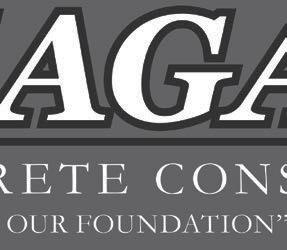












By TRENT BROWN Staff Reporter







If you qualify for either of two Illinois programs designed to gi ance to low-income immigr may need to renew your co losing your benefits with no way to get them back.
Members of the state’s Health Benefits for Immigrant Adults/Seniors programs will need to submit paperwork — for an annual benefits eligibility check that the state refers to as redeter mination — to renew their coverage for another year by Monday, July 15, or they may lose their insurance benefits effective August 1.
According to a written statement from Cook County Health, all information that immigrants provide during the redeter mination process “is used solely for program operation and is not shared for immigration enforcement purposes.”
The two programs have similar requirements to join, although registration for both is currently paused, as both programs have met their capacity and do not have the space to accept new members. For that reason, any members who do not renew their membership will not be able to reapply for health insurance after the redeter mination deadline has passed. According to Cook County Health, almost 35,000 low-income county residents have secured access to health insurance through one of the programs.


Members of the HBIA program must be Illinois residents between the ages of 42-64 who are either lawful permanent residents who hold green cards or undocumented immigrants, including anyone who has been granted temporary protected status by the federal gover nment.
An individual HBIA member must make $18,754 or less per year; members in households of two must make $25,268 combined or less per year. According to the Illinois Department of Healthcare and Family Services, the income limit “differs depending on the number of household members” beyond two.
The HBIS program is similar; the main difference from the HBIA program is which age group members fall into. HBIS members must be Illinois residents age 65 or older who have green cards or are undocumented.
The HBIS program has stricter financial requirements. Individual seniors must make $13,590 or less per year to qualify for the program, while couples must make $18,310 or less annually. Seniors on the program must also have assets worth less than $17,500.
According to Cook County Health’s statement, HFS mailed paperwork for the redeter mination process in April to all members of both programs
Members of either program can find their renewal due dates and confirm their mailing addresses online at abe.illinois.gov or by calling 800-843-6154. If you need in-person support to fill out redeter mination paperwork, you can find an upcoming event online at countycare.com/redeter mination. For more information about either program, visit the HFS website, hfs.illinois.gov.
A man was seen on video lighting restaurant linens on fire after they had been delivered to Shaker Management Company at 1100 Lake Street on July 5. The estimated damage is $777.50.
Someone stole clothes, marijuana, a cell phone, keys, jewelry and a Link card from an unlocked locker in the ambulance bay of West Suburban Medical Center on July 3. The estimated loss is $36,880.
Two men approached an unknown victim July 5 on the 200 block of Madison Street and displayed a firearm. One of the men then stole the victim’s phone and backpack. Both men fled in a black BMW that was driven by a third person. The estimated loss is unknown.
■ Someone shattered the rear glass door of an Oak Park residence on the 1100 block of North Kenilworth Avenue with a rock July 4. The person then reached inside to steal the resident’s key to a black 2016 Honda Accord. The person then stole the car and fled. The total estimated loss was $17,000, but the vehicle was recovered by the Riverside Police Department. Two minors were taken into custody.
■ Someone, who may have had a key, got into an Oak Park residence on the 1000 block of Pleasant Street between July 5 and 6. Inside, the person stole a black cashmere coat and two Burberry coats. The estimated loss is $2,300.
■ A 26-year-old Chicago woman was arrested for aggravated unlawful use of a weapon July 1 on the 1100 block of South Boulevard.
■ A 49-year-old Chicago man was arrested for retail theft and unlawful use of a weapon June 29 at the Walgreens at 6412 Roosevelt Road.
■ A 41-year-old Chicago man was arrested for criminal damage to property and criminal trespass to property July 3 on the 200 block of North Harlem Avenue.
■ A 60-year-old Oak Park woman was arrested for assault to another Oak Park resident and criminal damage to property July
3 on the 400 block of South Maple Avenue.
■ A 47-year-old man Hillside man was stopped by the Berkeley Police Department for a traf fic violation July 4 in Berkeley. He was arrested after a check revealed he had an active war rant for violation of an order of protection in Oak Park. He was turned over to the Oak Park Police Department and held for bond hearings.
■ A 61-year-old Chicago man was arrested for failure to register as a sex offender July 4
on the 500 block of South Oak Park Avenue
■ A 39-year-old Chicago man was arrested for driving under the influence after his involvement in a car accident July 6 on the 200 block of Madison Street. He was also charged with violating the Firearm Concealed Carry Act.
■ A 56-year-old Chicago man was arrested for battery to an Addison resident and retail theft to the Target at 1129 Lake Street on July 7.
These items were obtained from Oak Park Police Department reports dated July 1 – 8 and represent a portion of the incidents to which police responded Anyone named in these reports has only been charged with a crime and cases have not yet been adjudicated. We report the race of a suspect only when a serious crime has been committed, the suspect is still at large, and police have provided us with a detailed physical description of the suspect as they seek the public’s help in making an arrest

If you do, you should know how important foot care is. Over time, diabetics risk developing foot complications. When the nerves are damaged from chronic high blood sugar, feet can become numb or painful with burning or tingling. is is called diabetic neuropathy. When diabetes a ects the arteries, circulation to the legs and feet may be compromised. Either of these conditions may lead to serious problems including ulceration, even amputation.
e key to prevention is early diagnosis of diabetes, and regular foot exams from a podiatrist. Diabetics who receive regular foot care, including paring of calluses and debridement of thick fungal toenails, are almost four times less likely
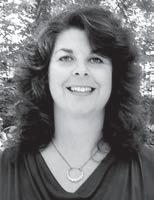
to undergo an amputation than those who do not seek treatment.
Medicare and some private insurances cover 1 pair of diabetic shoes and 3 pair of protective insoles each calendar year. Dr. Lambert has been a supplier of diabetic shoes since 2002. e shoes come in 30 di erent styles each for men and women. ese include boots, lightweight colorful athletic shoes, and dress shoes. Even patients who are not diabetic love the look and comfort of the footwear. Diabetic socks, slippers and compression hosiery are also available.
Protecting your feet with appropriate footgear is an important aspect of preventive care for diabetics.

By RISÉ SANDERS-WEIR Contributing Reporter
Circle Tavern and Union Tap in Elmwood Park anchor evening time in the village square – that just so happens to be a circle. Their food draws customers year-round, but summer is special, full of events and concerts.
“Our concert series in the Village Circle is really a great time,” said Skip Saviano, Elmwood Park’s village president. “It’s like a little street festival. We close Conti Parkway to car traffic and throw a concert every couple of weeks during the summer. Everyone is out enjoying the weather and their friends,” he said.

The Circle Tavern opened three years ago, yet owner Michael Jardine has deep roots in the area. He bought the place from his uncle.
“I feel like there’s no better location with what they’re doing across the street with the bocci, what they’re doing with the summer concerts and events all throughout the year. They’re very welcoming of me as a local business,” said Jardine.
This restaurant has a patio right on the Circle, all the better to enjoy summer specialty drinks. One is the summer splash, which is watermelon puree dashed with Malibu Rum and melon liqueur.
There are summer savories as well: fried pickles (if you haven’t tried them, trust me), a Southwest salad, and a “chicken bacon kicker” sandwich – loaded with chicken, bacon bits, diced tomatoes, cheddar cheese, layered over spicy chipotle aioli.
Mainstays on the menu are smash burgers – built to order and flatbread pizzas.
Owner Jardine is particularly proud of an addition to the menu. “We have the very, very thin crust, they call it tavern-style pizza. Super like cracker crust.”
Eventually the weather will turn cozy. In months that end in “ber,” a specialty burger each month keeps the winter interesting too.

Just a few steps away at Union Tap, the vibe is a little different, but just as family friendly as the rest of the Circle area.
Owner John Tate opened the bar in 2019. It is in addition to his City Tap and Grill in Norridge.
said. “We are open later than others nearby, which keeps the good times going.”
The bar is open until 1 a.m. Wednesday – Thursday. And until 2 a.m. on Friday and Saturday.
Their cocktail menu includes martinis, mules, mojitos and more. One of the most popular drinks is the white gummy bear martini. A wide selection of beer, wine and liquor is on offer as well. The food menu focuses on bites that go hand-in-hand with their excellent beverages.
Three sliders come out with crisp kettle-style chips. Wings can be tossed in any of four different sauces: BBQ,
parmesan. And if you can’t decide, they split an order of wings between two sauces. Burgers, salads, soups, nachos, pretzels … How can you go wrong?
There is plenty more summer to soak up at the Elmwood


“Elmwood Park has really embraced us. It’s been beautiful, like a home away from home,” said manager Gabriella Castillo.
Union Tap has an outdoor patio and a parking lot next door. Both give easy access for the crowds coming into the Circle in the summer.
“To look out and see all the crowds having fun at the events in the Circle. Everyone is so friendly. Big, but small community,” Castillo




circletavernep.com
















































By LACEY SIKORA Contributing Reporter
Riverside resident Michelangelo Sabatino has a deep interest in Ludwig Mies van der Rohe, the famed architect who shaped Chicago’s skyline. His new book, The Edith Farnsworth House: Architecture, Preservation, Culture, examines the work of the Germanbor n architect through the lens of the modern home he designed in Plano, Illinois (1945-1951) for Edith Farnsworth, a physician. T he book also shines a light on the collective effort that led to the purchase of the Farnsworth House and its opening to the public.

The book’s recent publication coincides with the 20th anniversary of the opening of the Edith Farnsworth House to the public in 2004.


Sabatino, a professor of architectural history and preservation at the Colle ge of Architecture of the Illinois Institute of Technology, previously partnered with historian and preservationist Susan S. Benjamin to pen Modern in the Middle: Chicago Houses 1929-1975.
That book looked at residential architecture in Chicago and its suburbs. The houses featured in the book showed the de gree to which both Mies and Frank Lloyd Wright inspired Chicago-based architects With his latest book, Sabatino said he hopes to encourage design, architecture, and nature
enthusiasts to venture outside of Chicagoland and take a field trip to Plano, Illinois. He said that he knows many architectural enthusiasts who travel outside the coun-








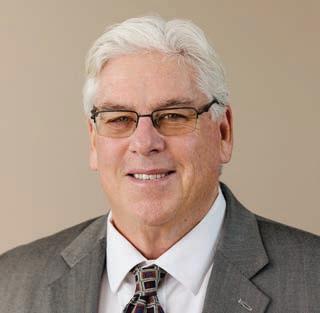











try to see sights, but tell themselves they can always get to a more local destination like the Farnsworth House at another time.
“The message to Chicagoans is to go visit, or revisit in different seasons, the nationally landmarked architecture in your own backyard,” he said.
Sabatino lamented the fact that more people seem to be familiar with the Farnsworth House through photographs than by having actually visited.
“By relying only on photographs, you cannot directly experience the beauty and complexity of the Fox River Valley site,” he said.
While visiting the home in person, he said, people can grasp the relationship of the groundbreaking floating glass and steel building to a site that is prone to flooding. Much is gained by leisurely taking in the house, with the help of
tor whose interests included photography, poetry, and music. The design and building process was anything but straightforward and took six years.
Today, the one room, 1,586-square-foot building is celebrated as an important example of International Style modern architecture. The home was listed on the National Re gister of Historic Places in 2004 and designated a National Historic Landmark in 2006. Although the initial purchase for nearly $7.5 million was made possible thanks to Landmarks Illinois, National Trust for Historic Places and Friends of the Farnsworth, the home is now owned and operated by the National Trust for Historic Preservation.
Sabatino pointed out that the house was renamed the Edith Farnsworth House in 2021 to reemphasize the role Farnsworth
“After all the controversy and gossip concerning the client/architect relationship it’s a really great opportunity to read directly her side of the story.”
A distinguished nephrologist, who in 1938 was the third woman to graduate from Northwestern University’s Medical School, Farnsworth was a pioneer in her own right.
While acknowledging the importance of Farnsworth in the creation of the home, Sabatino added: “I learned through the process that you cannot write a book about an important house like this one and just cover one of its lives.”
To that end, the book is divided into three parts concerning the three distinct owners: Farnsworth and Mies van der Rohe; subsequent owner, British developer and philanthropist Lord Peter Palumbo, who occupied
the home from 1972 to 2003; and the steward-
rsary of the opening of the ving one of Chicago’s most iconic national landmarks.
The Edith Farnsworth House is located about 60 miles south of Chicago in Plano, Illinois. The home and its grounds are open for tours Wednesdays through Sundays. Tickets are required. For more information or to purchase tickets, visit: https://edithfarnsworthhouse.org/tours/ Interested readers can support the EFH by purchasing a copy of Sabatino’s book directly from their visitor center shop: https://farnsworthhouse.myshopify.com
‘The
By JESSICA MACKINNON Contributing Reporter
Candace Fleming has doggedly followed the twists and turns of her boundless curiosity to bring to life some of the most fascinating characters in American history. An Oak Park author of more than 20 books for children and young adults, F leming has a special affinity for historical nonfiction that, while rooted in relentlessly researched facts, is as eng aging as the most fantastical fiction.
In a ddition to picture b ooks and two elementary serie s, F leming has w ritten bio gr aphies of the Romanovs, the Lincolns, A melia Earhart, P. T. Bar nu m and C harles Lindbergh, many of wh ich debunk popular misconc ep tions about their famous subject s.
S he has b een honored with the Boston Globe-Horn Award, the Cybils Award, the Golden Kite Award and the Los Angeles Times Book Prize, and many of her books have been selected as best books of the year by Publishers Weekly, Booklist and School Library Journal. In addition, she and her partner, illustrator Eric Rohmann, received the 2021 Robert F. Sibert Medal for their book, “Honeybee: The Busy Life of Apis Mellifera.” F leming and Rohmann, whose debut book, “Time Flies,” earned a 1995 Caldecott Honor, have worked together on several other books, including “Giant Squid, Mine!” and “Penny & Pip.”
“I love history because it is one long, e pic story. History has everything with every single one of us, and it has everything to do with how we live today. It’s all connected to how we used to live,” F leming said.
A born storyteller, F leming entertained childhood friends and family with stories
about Spot, her three-le gged cat, and the ghost that lived in her attic, and her family’s trip to Paris — none of which was true. Her parents appreciated her fibs — er, her imagination — and encouraged her to record them. She still has the many notebooks that she filled with stories, poems and plays.
Two b ooks in pa rt icular captured her imagination, b oth of wh ich we re b ased on true storie s. “Island of the Blue Dolphin s, ” about an A merican Indian gi rl who survives on a remote i sland by teaching herself to hunt and d omesticates a wild dog, depicted a protagonist she had neve r encountered in literature. After reading “Misty of Chincoteagu e, ” she wrote the author, Marguerite Henr y, and the Chincoteague C hamber of C ommerce, wh ich sent her an envelope of tourist info rm ation about the i sland ’s f amous wild pony roundup s.
F leming pursued her passion for history in colle ge, earning bachelor’s and master’s de grees in the subject. Only after having children and spending countless hours reading to them, including many evenings in which she be gged them to let her continue way past their bedtimes, did she decide to write her own children’s books.
She was for tunate to experience early success. She had numerous stories included in Cricket, Highlights and other children’s publications before serendipitously meeting an editor, Anne Schwartz of Random House Children’s Books, at a children’s literature conference. They have worked to gether for 30 years.
A meticulous researcher, F leming delights in the detours that her subjects often take her on. She also enjoys immersing herself in the world of her subjects. While writing her biography of P.T. Barnum, she learned how to play the steam calliope, walk a tightrope and ride an elephant.
The book that presented the most significant detour was her bio graphy of the Romanovs, the Russian royal family murdered in 1918 during the Russian Revolution. F leming initially planned to focus solely on Anastasia, the family’s youngest

daughter, but her research revealed that Anastasia wasn’t particularly clever or interesting, and neither were her siblings She eventually decided to write about the entire family, including Nicholas II and his wife Alexandra — and, to put them in context, she included background on the revolution and characters, such as the controversial mystic Grigori Rasputin.
“Context is so important for young adult readers,” F leming said. “Kids today have all the facts at their fingertips — all they have to do is pick up their phones. But they don’t necessarily have the context and connections to explain what the facts mean. Nonfiction isn’t just a fact-holder — you have to create a page-tur ner that is written as nar ratively as possibl e.”
As part of her research, F leming and Rohmann traveled to Russia and visited the 100-room country palace where the Romanovs moved to escape St. Petersburg. She was surprised to discover that it was separated only by a wrought iron fence from the peasants and workers that the family had wanted to get away from.
“I realized that I still didn’t have the entire story and I had to include the Russian peasants and soldiers and shopgirls. What started out to be a short book about Anastasia became a much bigger and more complex project,” Fleming said.
F leming is now working on a book about the 1978 mass murder-suicide in Guyana
of more than 900 followers of Jim Jones, the leader of the People’s Temple organization. She has interviewed survivors and family members of the deceased, including the son of Jim Jones, and was surprised by how many insist that the organization was fun and altruistic before becoming war ped after the move to South America. Once again, context is important.
“I want my teenage readers to understand that this is about individuals who were influenced by a destructive force. They were real people’s friends and family members, not just crazy people,” Fleming said.
“The book is so relevant — wherever you land on the political spectrum, you see the ne gative influence that some people can have. I see people today who are willing to toss away fact and rationality,” Rohmann said.
F leming also is planning a book about wildlife poaching, inspired by a recent experience she and Rohmann had at a conservancy in South Africa. F leming envisions the book as a true crime story. T hey will be returning this f all to Africa, where they will work in a rhino or phanage while F leming attends a wildlife forensics conference.
F leming’s books combine all the things she loves most about writing — storytelling, history and lyrical language. Her young readers eagerly await the results of her endless curiosity
DEADLINE FOR SUBMISSIONS IS FRIDAY 5 P.M.
Call Viewpoints editor
Ken Trainor at 613-3310
ktrainor@wjinc.com
The second installment property tax bills mailed in early July are the first to reflect the 2023 reassessment of Oak Park properties. They also reflect the annual tax increases for local governments serving Oak Park
This year, Oak Pa rk property owners are collective ly paying $255 million in property taxes. This sum, the Oak Pa rk tax burden, is the combined le vy of all taxing districts serving Oak Pa rk . This year ’s tax burden is 6.2% higher than it was last y ear and if there had not been a reassessment, tax increases would have been about 6.2% fo r most Oak Pa rk proper ties

Oak Park Township Assessor
The reassessment did not hange Oak Park’s tax burden. But it did change each property’s share of the tax burden and the esult is dramatic changes to individual tax bills:
• About 35% of Oak Park homewners are paying less this year than last year
• About 25% of Oak Park homeowners have annual tax increases of less than 10%.
• About 40% of homeowner s have double-digit tax increases, with a little more than half of the “double-digit” gr oup experiencing tax increases of 20% or more compared to last year
How do you explain the wide variation in Oak Park’s tax bills?
T he simplest explanation involves two numbers: the 6.2% increase in tax levies; and the 29% overall increase in the taxable value of Oak Park properties due to reassessment. If the increase in the taxable value of an individual proper ty matches Oak Park ’s 29% increase, there will be no change in the proper ty ’s share of the tax burden. Its tax increase will match the 6.2% levy increase
But properties with valuation increases that exceed 29% will see their taxes rise by more than 6.2%, as such properties will also be paying a greater share of Oak Park ’s tax burden. Co nversely, if a proper ty ’s new valuation does not reach the 29% threshold, it will pay a smaller share of the tax burden and its taxes will either decrease or increase by less than 6.2%.
Shrubtown: A wo debate with ra


ITrump doesn’t honor the military
have to disagree with Mr. Jonathan Panton’s letter titled, “America needs a new leader” [Viewpoints, July 3] in which he states, “America deserves a President who will honor our fallen and keep our homeland safe.” He calls for the election of Donald Trump
One View
Let’s look at Mr. Trump and a brief glimpse of his record with the military. In an Oct. 15, 2016 article in People magazine, Mr. Trump is quoted from a 1993 interview on the Howard Stern show: “Trump bragged about his promiscuous lifestyle while single and stated that men who didn’t go to Vietnam didn’t need to feel guilty because dating during the AIDS epidemic in the ’80s was also dangerous. You know, if you’re young, and in this era, and if you have any guilt about not having gone to Vietnam, we have our own Vietnam — it’s called the dating game Dating is like being in Vietnam. You’re the equivalent of a soldier going over to Vietnam.”
Does Mr. Panton think the 2.7 million men who served in Vietnam, and the over 58,000 who were killed there, agree with Mr. Trump’s idea of the dangers of dating vs. fighting in Vietnam?
In an August 31, 2020 issue of Military Times, after four years of President Trump acting as commander-in-chief, “a survey of active duty troops found 49.9% of them had an unfavorable view of him. More than 59 percent of officers said they have a poor view of the president, with more than half saying they strongly disapprove. Among enlisted
respondents, 47 percent said they have an unfavorable view.” Those are the views of the actual men and women who have volunteered to risk their lives to defend our nation and keep our homeland safe. They personally experienced the failed leadership of Donald Trump
The total failure of Donald Trump as a commander-in-chief was set forth in a Sept 3, 2020 issue of The Atlantic. The article reported that “President Donald Trump canceled a visit to the AisneMarne American Cemetery, near Paris, in 2018 … because he did not believe it important to honor American war dead, according to four people with firsthand knowledge of the discussion that day. In a conversation with senior staff members on the morning of the scheduled visit, Trump said, ‘Why should I go to that cemetery? It’s filled with losers.’ In a separate conversation on the same trip, Trump referred to the more than 1,800 marines who lost their lives at Belleau Wood as ‘suckers’ for getting killed
“On Memorial Day 2017, Trump visited Arlington National Cemetery, a short drive from the White House. He was accompanied on this visit by John Kelly, who was then the secretary of homeland security, and who would, a short time later, be named the White House chief of staff. The two men were set to visit Section 60. Kelly’s son, Robert, is buried in Section 60. A first lieutenant in the Marine Corps, Robert Kelly was killed in 2010 in Afghanistan. He
Property taxes are confusing. Sometimes bedeviling.
The second installment property tax bills which hit most Oak Park mailboxes just before the 4th of July are both those things.
For about one-third of Oak Park property owners they’ve seen their property taxes actually fall from a year ago. One-quarter of property owners have had hikes of less than 10%. And for the unlucky 40%, mainly those in larger homes, they’ve been officially clocked with increases of 20% or more.
To make sense of all this, Ali ElSaffar, the longtime Oak Park Township Assessor, has penned a One View in this week’s Journal laying out the complicated equation that brings us to this moment.
First, he writes, this installment of property taxes reflects the high inflation levels we saw in 2022. That pandemic-related hike allowed most local taxing bodies to increase their take to the maximum of 5% tax allowed. Note that Oak Park’s village government stuck to its self-imposed limit and raised its tax burden by just 3%.
Those higher-than-usual hikes averaged out to a 6.2% increase in tax money actually going to local taxing bodies.
Second, Oak Pa rk is f eeling the direct impact of the C ook C ounty A ssessor ’s recent t riennial r eassessment of local properties. That reassessment increased the taxable value of all Oak Pa rk proper ty by nearly 30%. Th at ’s a good news/bad news outcome. It is g ood that the overall v alue of our c ollective properties r ose. But if within that process the v alue of your specific property increased significantl y, you are now on the hook to pay a gr eater proportion of the total tax bil l in town.
Oak Park is for tunate to have ElSaffar as the local assessor. He is able to translate what is exceedingly complicated into language that makes sense to the highly-taxed masses.
We’ ll close out on the big picture. Oak Park’s taxes are high. This is an expensive town to run. The infrastructure is old. The ambitions in our complex schools are high. The commercial tax base is limited and there is, by choice, no industry. And over decades we had too many elected officials who did not focus on containing costs.
That has changed some. The village government, which gets only a modest share of property taxes but puts a fee on everything that moves, has shown true restraint on that revenue stream. Oak Park and River Forest High School was long the greediest and least self-aware of its toll on property taxpayers. Its cash reserve reached well above $100 million at its peak and alienated a lot of its constituents. Over the past decades it has taken intentional steps to lower that reserve and to limit pay hikes for teachers to more sustainable levels.
But property tax saturation is a real thing in Oak Pa rk. A shock to the system as felt right now by 40% of our neighbors is a moment to remember that these are real people, working hard to make their way, who get stung when these tax payments come due.
Seems li ke a question wo rt h asking in an election year, especially this election year, b ut I wonder how many voter s actually do ask themselves — and each other — that question. I also wonder why we do n’ t.
About the closest we ever come is asking, “Which candidate would yo u rather have a beer with?” It ’s hard to imagine anyone at this point wanting to have a beer with Donald Trump, b ut I would be happy to have a beer (or glass of wine or cup of co ff ee or tea) with Joe Biden. When he talks “with” people (not just “to” people), he sounds authentic and genuinel y i nterested. I think he cares and is curious to know wh at they ’r e going through. Maybe that’s because he’s been through so much. He’s goin g through a lot right now with his son, Hunter, and the calls to not run for re-election.
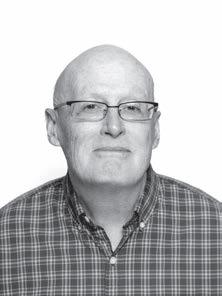
It makes him more empathic, but also tough. He has faced enough adve rsity to know wh at it takes to pers ever e. The only thing Trump knows how to do is skip out on his debts and dodge the c riminal justice system. Biden gr ew up in the wo rk ing class and hasn’t forgotten where he c omes from. Trump came from privil eg e. It ’s much easier to relate to Biden.
Many voters seem to crave that ineffable quality known as “charisma,” which is overrated because it can be used to cover up a host of sins — and character defects. With charisma, you never know if you’re g etting the “real deal” until after Election Day. Trump is too crude and mean-spirited to be considered charismatic. Biden’s charisma is understated, but he’s the real deal.
A president needs a sense of humor, which Biden has and Trump does not. Biden’s a good storyteller. The only time Trump gets a laugh is when he puts someone down — or kicks someone who’s already down, leading to hilarity among his supporters. Trump hardly ever smiles. Biden has a warm grin. Trump’s looks more like a face cramp. And his stories sound more like a brain cramp.
Put it this way: Which one would you leave your children or grandchildren with in an emergency? Experience is more important than charisma. I want a President who knows how gove r nment wo rks so he/she can make it wo rk even better B iden knows more about gove r nment than anyone because he’s been involved since the age of 29. Fo r the past 3½ years he and his administration made gove r nment wo rk — not for himself or his pa rt y but for the American people. Trump had no gove r nment experience when he was elected (and his experience with business was mostly b ankruptcy). His administration, no sur pris e,
was dy sfunctional, chaotic, and, of c ourse, bankrupt.
I want a President whose eg o is n’t bigger than his/her desire to help other s. Biden has a strong service ethic and sense of mission. Meanwhile, there’s no room in Trump’s ps yche fo r anyone but himself — unless he ca n profit from it
I want a President who is n’ t afraid to admit his/her mistakes, and wh o lear ns from them. Biden acknowledges misste ps, including his poor debate perfor manc e. Trump just blames everyone else
I want a President who tells the truth most of the time. Trump doesn’t know how to tell the truth.
I want a President who wields powe r as a means toward progress. Trump seeks powe r mostly to ke ep himself out of jail
I want a President who is in touch with realit y, who exudes self-confidence based on results rather than bravado and empty promises, who is c ommitted to becoming a better person instead of spending all his time trying to fool people into thinking he’s better than everyone else
I want a President who finds strength through c ollaboration and cooperation, not just competition, who beli eves using powe r multilaterally is better than going it alone, who takes a fir m stand based on principl e, as Biden did with Ukraine, and leve rages that strength with the a id of allies. The only principle Trump knows is self-preservation. As for ethics, as Biden said in the debate, Trump has “the morals of an alley cat.” He makes common cause with dictator s because they ’r e the only ones he understands — as self-obsessed as he is
S ome voters would prefer a crazy bastard wh o makes the leaders of other countries quake with fear. I want someone who inspires respect rather than fear and motivates with cooperatio n i nstead of coercion.
I want a President who is visionary enoug h to beli eve pr ogr ess is possible and pragmatic enough to make it happen, even when the odds are ag ainst it. Trump ’s only vision is that our c ountry is a hellhole — except when he’s in c harge. Then it magically becomes perfect Magical thinking is not high on my list of presid ential traits
Mostly what I want in a President is a decent human being who has the desire and collaborative skills to improve people’s lives.
I do n’ t need him/her to be ve r sed in the art of the deal.
I want someone who can make the ideal real. What do you look for in a president?

Because I ag r ee with them on the issue, I’ ve enjoyed the letter s c omplaining about the Oak Pa rk Vi llage Board’s decision to end the b enefit of raking leaves into the g utter for street swee ping, instead requiring the proper ty owners to bag the leaves for pick-up.
In last week’s edition, I ag r eed with the letters from Melinda Murray and Ro be rt Pa rk s. Ms. Mur ray’s cited not only the board’s failure to listen to residents’ opinions on bagging leave s, but also past decisions over riding the opposition to tall buildings and the Madison Street Road Diet. Re ga r ding tall buildings, I beli eve she is refer rin g to the one at Madison and Gunderson, the zoning variances for wh ic h we re denied by the Plan Commission but approved by the village b oard on appeal by the developer
I was very interested to lear n from Mr. Parks’ letter about the slim majority of the village board’s unwillingness to amend the decision eliminating the “street-swee p leaf pickup,” particularly the comments by Trustee Corey Wesley. The public, especially the voters should know that his comments against fur ther discussion of the leaf-bagging controversy were not his first opposing public participation.
On one occasion in 2023, and again during the A pril 11 meeting this year the village board agend a included a discussion of the “Public En gag ement and Development E ntitlement Processes.” In shor t, the board has been considerin g amending the public comment requirement for public hearings on such issues as petitions for planned developments, zoning variances,
and special-use pe rm it s. Trustee Wesley is n’ t in favo r of changin g the existing standard.
It is important to note that each published “Public Hearing Notice” on such matters includes the sentenc e, “A ll interested persons will be given an opportunity to be heard at the public hearing.” On April 11, Trustee Wesley stated he would not ag r ee to any amendments to the cu rr ent process unless there is more dive rsity and equality among those making public comments as well as in their opinions.
Ag ain, referencing the letter from Mr. Pa rk s, public comment should not be limited on decisions by the village board, especially those made between elections
Chris Donovan Oak Park
of Oak Park and River Forest
e goal of the Viewpoints section is to foster and facilitate a community conversation and respectful dialogue. Responsible community voices are vital to community journalism and we welcome them. Space is at a premium and readers’ attention is also limited, so we ask that Viewpoints submissions be brief. Our limit for letters to the editor is 350 words. For One View essays, the limit is 500 words. Shorter is better. If and when we have su cient space, we print longer submissions, but when space is limited — as it o en is — we may ask you to submit a shorter version or hold the piece until space allows us to print it.
We reser ve the right to edit submissions. We do not have time to allow the writer to review changes before publication. We also do not have time to do more than super cial fact-checking, and because of our national epidemic of misinformation and conspiracy theories, when writers include statistical evidence to support their opinions, we require them to include the source of that information, such as credible websites, print publications, titles of articles and dates published, etc. Be as speci c as possible so that we and our readers have some way of assessing the credibility of your claims. Links may also be included for the online version. We follow the Society of Professional Journalists’ code of ethics: seek the truth and report it and minimize harm. As a result, we will do our best not to publish pieces that espouse doubtful or debunked theories, demonstrate harmful bias, or cross the line into incivility. While we will do our best not to engage in censorship, we also do not intend to be used as a platform for misinformation. Your sources for fact-checking are a critical step in keeping the discourse honest, decent and respectful.
All submissions must include your rst and last name and the municipality in which you live, plus a phone number (for veri cation only). We do not publish anonymous letters. One View essays should include a sentence at the end about who you are.
If we receive your submission by 5 p.m. on Sunday, you can expect your opinion to be included in that week’s paper (and online), space permitting.
Pieces can be submitted through our online form at oakpark.com or directly to Viewpoints editor Ken Trainor, ktrainor@wjinc.com. For the latter, we prefer attached Word les or plain tex t included in the email.
■ 350-word limit
■ Must include rst and last names, municipality in which you live, phone number (for veri cation only)
‘ONE VIEW’ ESSAY
■ 500-word limit
■ One-sentence footnote about yourself and/or your connection to the topic
■ Signature details as at left
Here we are in 2024, and the Oak Park Regional Housing Center is facing questions concer ning its management and finances. A core of citizens in our village ar e r eacting as they have always have — by a ttacking the board members, questioning their commitment to racial inte gr ation, telling board members they are rude, etc
It ’s a re peat perfor mance that places the Housing Center as a sacred cow. Asking tough questions is not being rude. S eeking reasons to continue using tax d ollars for the Housing Center is only
reasonable to this core of individuals. If you do n’ t ag ree with them, they say, it ’s because you are too ignorant, or yo u “don’t care” for the mission.
T here is no doubt that the Housing Center’s purpose is important. There is no doubt its impact on Oak Pa rk has helped to foster and maintain inte gration.
However, it may be time for an institutional chang e. Pe rhaps it ’s merely a management issue. Maybe an ad hoc citize n’s committee could look at the finances, management, the cu rr ent wo rk ing model and research other ap -
proaches. Adaptation, Darwinian style, might wo rk . Sacred cows need to be looked at c losel y. Just giving money to the “c ow ” d oesn’t mean it ’s going to be OK. Pe rhaps it is time to create a purp le cow a creative, updated, revised ve rsion of the Housing Center Institutions do die. But that doesn’t mean the mission needs to die, too. Restructuring is a real option and an opportunity to be even better!
Robert Milstein
Former Oak Park villa ge trustee
To all naysayers:
President Biden has done more for the wealth, welfare and democra cy of our c ountry than Mr. Donald Trump Revie w their curriculum vitae
To those who cannot see moral principles, ethics and inte g rity of our
IPresident’s character, that remained pr ev alent as he aged. I want you to visualize you at his age … compare your a ccomplishments to hi s. See your state of aging on your mind and bo dy without the multi-demands that come with hi s r ole as President of the United States.
Fellow citizens, being a senior citizen has numerous advantag es: experience, knowledge, know-how and wit! Bravo to all of us seniors!
Dorothy Wright Devoted supporter of a senior president
Visitors are impressed and enjoy Oak Park’s urban forest. Neighbors have mourned when a large shade tree dies and is removed. This wonderful, beautiful urban forest needs care when the leaves and needles drop in the fall. Sometimes the obvious solution is missed
T he problem cited is the corner streets stacke d with leaves after the village has pl owed our streets on a scheduled removal of leaves in front of our homes. An easy solution is removal of those piles of leaves the following morning. Fo r many, the requirement to remove leaves via bagging will be difficult physically. S tacks of bags and rainfall — wh at a disaster
Our village board is causing a problem for many of its citizens. An easy solution is in front of them. Remove the leaves from the corners the morning following the removal in front of our homes.
Joyce Cassel Oak Park
n plain language a third-grader could understand, the Constitution says that an ex-President can be prosecuted for treason, bribery or other crimes committed while in office. Everybody knew that for 235 years. Mitch McConnell knew it when he said Trump could be prosecuted later. Even Trump said it, through his lawyers, at his impeachment trial. Now the Supreme Court says he cannot.
The Constitution: “The President, Vice President [and others] shall be removed from Office on Impeachment for, and Conviction of, Treason, Bribery, or other high Crimes and Misdemeanors … but the Party convicted shall nevertheless be liable and subject to Indictment, Trial, Judgment and Punishment, according to Law.” (Bribery can only be committed while in office; but plenty of “other crimes” can be, too).
The Court: An ex-President cannot be prosecuted for bribery for “of ficial acts” while in office, if done under “core” functions assigned to him by the Constitution, such as pardons, or vetoing a law passed by Congress. His motivations for such acts cannot even be looked into, making a pros-
ecution for bribery impossible. On that premise, he could not be prosecuted for taking a million-dollar bribe in exchange for issuing a pardon, or a billion dollars from the oil industry for vetoing a law passed by Congress, which are functions assigned to him by the Constitution. In addition and on a similar premise, the President can conspire with the Attorney General to commit all sorts of crimes because, by statute, Congress has created the Justice Department and the office of AG as part of the executive branch, so anything he does with them is also an “official act” within functions assigned to him by law, under the Constitution. And so on, subject only to a vague exception with such a high bar that it would likely never pass muster before this court, which would be inevitably called upon to approve it. And the exception does not even apply to “core” official acts. The immunity there is absolute.
The Constitution says no such thing, so where do such conclusions come from?
It all comes down to this from the court:
“The nature of Presidential power requires that a for mer President have some immunity from criminal prosecution for of ficial acts during his tenure in of fice.”
That, and a lot of sophistry, in the form of reasoning upon that premise, that would take too long to dissect here, but which, as a retired lawyer, I can say gives lawyers and law a bad name, and makes a mockery of the words chiseled above the Supreme Court’s entrance: “Equal Justice Under Law.” Not so any more. The President is now above the law. “The King can do no wrong.”
This ruling is not a statement of what the Constitution says or even implies. It is a political statement, a judgment of what six justices think it should have said. It re-writes and amends the Constitution as it stood for 235 years, without the consent of the American people required for such amendments
An extremist wing of the Supreme Court has not performed its true function of interpreting the Constitution. Instead, it has written a new one. More simply put, they made it up, something that is clearly not in
the Constitution — in fact opposed to what is expressly in it: the President is free to commit whatever crimes he wants.
And we have someone who has proved he will do exactly that, in a pre-announced program to work his will in all its worst desires. And, if not him because he is not elected, someone else in the future inevitably will.
“Absolute power corrupts absolutely.”
Th at is a plain prescription for the end of democra cy.
The decision is one of constitutional character, now baked into the Constitution. So no law of Congress can change it; Congress is powerless here. Only a constitutional amendment can remedy this, which requires the approval of 38 states. No state, of whatever political persuasion, can justifiably oppose what restores a universal reading since the country’s founding. It is a difficult path and a long one. But that is the only way out of this, and it must begin now.
I call upon my senators, Dick Durbin and Tammy Duckwor th, and upon my re presentative, Danny Davis, to immediately introduce resolutions proposing such an amendment.
Frank Stachyra is an Oak Park resident.
The old rule of thumb is that bad news comes in threes. That rule is not expansive enough to cover the general incompetence and arrogance of Oak Park village government and the Oak Park Village Board.
First up is the rightly maligned decision to force Oak Park residents to bag all the leaves falling, mostly, from village-owned trees on parkways. No need to revisit all the reasons this is such a bad move. But what is just as aggravating is the condescension demonstrated by the village board, which not only did not seek public input, but chose to actually ignore that input when offered.
Following closely on this first bit of bad news is the infuriating language in the “OP/FYI” newsletter which the village just mailed to us all (on our dim e, of course). To call this propaganda is to give propaganda a bad name. We are told, proudly, that the village is “modernizing” leaf collection, “address[ing] resident concern” over alleged safety hazards, and “reduc[ing] confusion.” Now, we have choices, thanks to the enlightened village board! Never mind that the choices are identical to what we have always had, except now we have no choice but to bag leaves for pickup No, this is not propaganda, it is gaslighting.
Third wave of bad news: We read in the July 3 Wednesday Jour nal that Forest Park, but not Oak Park, is finally taking action against dangerous funeral processions coming through that village, and ours. Our
neighbor to the west has for med a task force, enlisted help from Springfield, and hopes for legislation to address this problem. Oak Park? Nothing.
Fourth wave of bad news: The village gover nment looks like fools as Pete’s does nothing about the eyesore on Madison. Why should it? Our village gover nment is too incompetent to force action. Instead, we have a new “Stankus Hole” in Oak Park Newcomers may need to look that one up to see how gover nment incompetence repeats itself.
Fifth, and I may be cheating by listing this one separately, we are still suffering from the board’s decision to implement the Madison Street “diet.” If anything, that street is more unsightly now than before the diet. In fact, all we have to show for it are interminable traffic jams on Oak Park Avenue where it now takes multiple red-light sequences to get past Madison. And remember: this is not a defect in the diet but a feature which was clearly predicted in the village’s own study on the diet.
Last, there is the old, old, old eyesore of the vacant Marshall Field building on Lake Street. What has the village government done? What has the village government accomplished? Nothing
Let’s stop at six items, leaving unmentioned our always increasing property taxes and decreasing levels of service. For how long must we tolerate such striking levels of incompetence by village government and arrogance of those we have elected?
Jerry Bowman is an Oak Park resident.
T he Oak Pa rk Vi llage Board’s leaf-bagging decision is a slap in the face to voters who overwhelmingly o ppose it, and I for one will vote a ccordingly. We d nesday Journal, though, also has failed us Your cove rage has b een meek and shallow. T he story re po rt ing the b oard’s final vote was buried inside the newspaper. Your stories re peatedly allow village officials to claim there are annual leaf-pile fires; when and where did those happen? A quick internet search turns up nothing
except the now-infamous fire in November 2023. You allow them to claim concerns about child safety, but are there any data to support those claims? There has been no report of such an accident. Those village officials also claim parking, biking, and flooding concerns. Again, where and when and how severe? We d nesd ay Journal is an award-winning newspaper. It is time to step up and do your jo b.
After reading numerous complaints about leaf collection, I felt I had to put my two cents in. I am delighted that there will no longer be piles of leaves lining the streets, greatly reducing the driving lanes and clogging the sewers if there is rain
It might be tolerable if residents followed instructions and waited to put the leaves in the street until the night before, but that clearly is not the case. Piles of leaves begin to appear the day after pickup. Large branches are often incorporated into the pile.
My husband and I have never had an issue with disposing of our leaves and we haven’t bought bags. For years we have subscribed to the village’s composting program. You can fit a lot of leaves in that big grey bin. The village would have to extend the weekly compost into December, but that seems like an easy fix The village offers four options. They all seem reasonable to me.
Here’s my take as a Democrat: Joe Biden needs to step down from the upcoming presidential election because, after the recent debate, he can no longer defeat Donald Trump.
With Biden in the pole position, Democrats are now likely to lose both the U.S. House and Senate. This result could have disastrous implications not only for the next four years but also for our Constitutional democracy, in light of the recent Supreme Court opinion on presidential immunity and Trump’s plan to “be your retribution.”
My eyes c annot un-see wh at I saw in the first 20 minutes of the debate before I turned it off: B iden was a c onfused old man. And things would only g et wo rs e if he we re elected and survive d to 2028, when he would be 86 years old
Last Friday’s interview with George Stephanopolous did nothing to change my opinion, particularly his refusal to acknowledge that he is losing to Trump in the polls and that his approval rating is, and has
been, around 36 percent.
This is not about Joe B iden doing hi s b est and losing to Trump. It ’s about defeating Trump and the threat to d emocra cy he re presents
I’d take Kamala Harris over Biden. Her chances would be better than the certainty that Biden will now lose
And I’d prefer Gretchen Whitmer, the p lain-spoken gove r nor of Michig an wh o was recently re-elected by 10-plus points in a pu rp le battle ground state. At our cabin in the U pper Peninsula of Michig an, I have watched Whitmer succeed even in de ep red rural areas through practical policies
T he Book of Proverbs says that “ pride g oeth before the fall.” Joe Biden is a good man and a successful President, but hi s pride in staying in the race c ould lead to the end of democra cy as we know it . Jack Crowe Oak Park
A brief comment on the Oak Park Regional Housing Center:
In your editorial of June 26, you write “mismanagement not malfeasance” concerning the financial mess at the Housing Center. Has an audit been commissioned by an outside firm to perform an in-depth au-
dit of the Housing Center finances? If so, what are the findings? If not, one should be so commissioned.
William E. Douk as Certified Fraud Examiner U.S. Treasury (retired) Oak Park
Park
Stephan Benzkofer Oak
Aconference on emotional cutoff in the family will be held on Friday, July 26, at the Carleton Hotel in Oak Park. Hosted by the Center for Family Consultation, this will be a day of exploring the Family Systems Theory developed by psychiatrist Murray Bowen. A leading scholar of Bowen theory, Dr. Anne McKnight will lead the conference. She brings four decades of practice as a family therapist to her knowledge of the emotional process in families. This conference is open to the public. Information on registration can be found on this website: https://thecenterforfamilyconsultation.com/summerconference/2024-summer-conference.
the relationship problems they have tried to escape. At this point, partners will often wonder how, despite their efforts to leave their problems behind, start over and do better, they are having as many or more problems than they had in their parental families
Gun violence is an ongoing issue in countries across the world. The younger people of Oak Park are not aware that even the smaller, less hurtful guns can still cause various injuries and consequences
Bowen defined emotional cutoff as “the process of separation, isolation, withdrawal, running away, or denying the importance of the parental family.” Growing up and becoming a relatively autonomous individual is a challenge that brings one face-to-face with the degree of one’s emotional attachment to one’s parents
For those who can address this with emotional maturity, the process of gaining autonomy and separating emotionally from parents occurs gradually from childhood and goes smoothly in young adulthood. When the level of stress and emotional reactivity in the family is more intense, the process is more difficult. For some young adults, cutoff may be seen as the only way to preserve self and gain independence. Parents are seen as the problem and getting away as the solution. Some deal with the discomfort by isolating themselves emotionally while still living at home or close to the family; others need physical distance to achieve a degree of emotional distance. Most people use a combination of internal and physical cutoff.
Moving into a new relationship that promises freedom often seems like the solution. However, one does not gain emotional maturity by cutting off from parents. People bring their immaturity with them into new relationships and will predictably replicate or intensify
Cutoff in one generation begets cutoff in the next, as children who grow up in more intense family emotional climates are likely to replicate the pattern as a way of managing relationship tensions. Over generations, emotional cutoff is costly to individuals and families. It takes a broad perspective to see this. In the midst of cutting off, people are relieved to get away from a difficult relationship; they do not see that they are leaving behind valuable resources available in an extended family
In Bowen’s words: “In general, the greater the cutoff with the past, the more likely the new family is to become a ‘cocoonized’ family fragment, and the more vulnerable the family is to disabling symptoms in the future.” In the longer term, as cutoffs beget more cutoffs, whole branches of families lose contact with one another and the fabric of the family is weakened. A lifetime of successive cutoffs is likely to end in loneliness and isolation.
Cutoffs can be bridged, contact can be re-established, and people can reclaim to a significant extent the emotional connection that has been lost through cutoff. Study of one’s family and moving toward a more objective and systemic view are first steps. With an enlarged perspective, one begins to see cutoff as a product of the family emotional system and to see one’s own part in the reactive family patterns
As described by Bowen: “The study requires that the researcher begin to gain control over his emotional reactivity to his family, that he visit his parental family as often as indicated , and that he develop the ability to become a more objective observer in his own family.”
With this view, possibilities for change open up. It is a well-proven avenue for growth in one’s own maturity.
Stephanie Ferrera is a family therapist, and partner in Center for Family Consultation.
Re ga r ding the f uneral procession task force in Fo r est Pa rk , I offer this observation in Oak Pa rk . Division Street is a frequent r oute. My unscientific estimate is that 75-80% are careful, slow-
moving processions. I’ ve witnessed some rowdy ones, too, b ut they are the exce ption on Division.
Mary Jane Keitel Oak Park
Gel gun blasters should not be allowed in town, specifically Oak Park, for a bunch of important reasons. Firstly, these toy guns have the potential to hurt random and innocent people who may come into contact with them unintentionally or during play. For example, a gel gun blast aimed at one person could easily hit someone nearby who is not involved in the game
Secondly, gel gun blasters can cause significant harm as they shoot small orbee bullets at high speeds which can lead to injuries ranging from bruises to more serious wounds if aimed improperly or used irresponsibly, which has been noticed in these past few weeks. Instances of eye injuries and skin irritation have been reported due to misuse of these guns.
And finally, the fact that these items are being sold to young individuals raises concerns about safety and proper usage by those who may not fully understand the consequences of their actions. This might make children and teenagers curious enough to purchase these gel guns. Younger users might engage in risky behavior without realizing the potential dangers associated with using gel guns. This irresponsible use of the gel gun results in many police calls in which the guns are confiscated or the user is further in trouble
Recently there have been reports of citizens being shot in the eyes and arms by young individuals at Scoville Park
Gel guns should be banned in Oak Park to ensure public safety and prevent unnecessary harm caused by irresponsible use.
Hadrian Kim Boy Scout Troop 16
Supreme Court Justice Clarence Thomas is quoted [1] as saying, “In my view, Illinois’ ban is highly suspect because it broadly prohibits common semiautomatic firearms needed for lawful purposes.” I would like to know what lawful purpose is served by a semiautomatic weapon. Do hunters really need such extreme firepower to kill scary animals? Obviously, there is no legitimate
from page 29
was 29. Trump was meant, on this visit, to join John Kelly in paying respects at his son’s grave, and to comfort the families of other fallen service members. But according to sources with knowledge of this visit, Trump, while standing by Robert Kelly’s grave, turned directly to his father and said, “I don’t get it. What was in it for them?”
“Trump’s understanding of concepts such as patriotism, service, and sacrifice has interested me,” wrote Atlantic author Jeffery Goldberg, “since he expressed contempt for the war record of the late Senator John McCain, who spent more than five years as a prisoner of the North Vietnamese. ‘He’s
use for semiautomatic weapons in civilian hands. These weapons exist for one purpose only — to kill large numbers of people in a very short time. Massacring human beings is not a Constitutional Right. [1] “Illinois gun ban case gets reprieve,” p. 1, Chicago Tribune, July 3.
Tom DeCoursey Oak Park
not a war hero,’ Trump said in 2015 while running for the Republican nomination for president. ‘I like people who weren’t captured.’”
George Galloway a British politician, broadcaster, and writer who has served as Member of Parliament, once said, “There are those who wrap themselves in flags and blow the tinny trumpet of patriotism as a means of fooling the people.”
Since I am writing this on the 4th of July, we can always declare our Independence from the Brits and look to author Sinclair Lewis’ 1935 comment: “When fascism comes to America it will be wrapped in the flag and carrying a cross.”
If Mr. Panton is looking for a new leader who will honor our fallen and keep our homeland safe, I suggest he is looking at the wrong man.
Alan E. Krause is a Vietnam veteran and a 70+ year resident of Oak Park.
I
filed a successful tax appeal, but my taxes still increased significantly. How is that possible?
Imagine the proposed increase in your 2023 assessed value was 70%. If you filed an appeal that reduce d the assessment increase to 45%, yo u pr evented a spectacularly lar ge increase in your tax bill. But since the 45% increase is higher than the 29% increase in Oak Pa rk ’s taxable value, your share of Oak Pa rk ’s tax burden still increased. The increase, however, is smaller
My homeowner exemption and some other exemptions are worth less than last year. Why?
T he homeowner exemption is calc ulated by multiplying $10,000 by the proper ty tax rate. But property tax rates fluctuate and typically fall after a r eassessment with rising property values. This year, Oak Pa rk ’s tax rate fell by 18% due to the reassessment, wh ic h led to an 18% drop in the homeowner exemption’s value. Some, but not all, of the other exemptions also fell in value
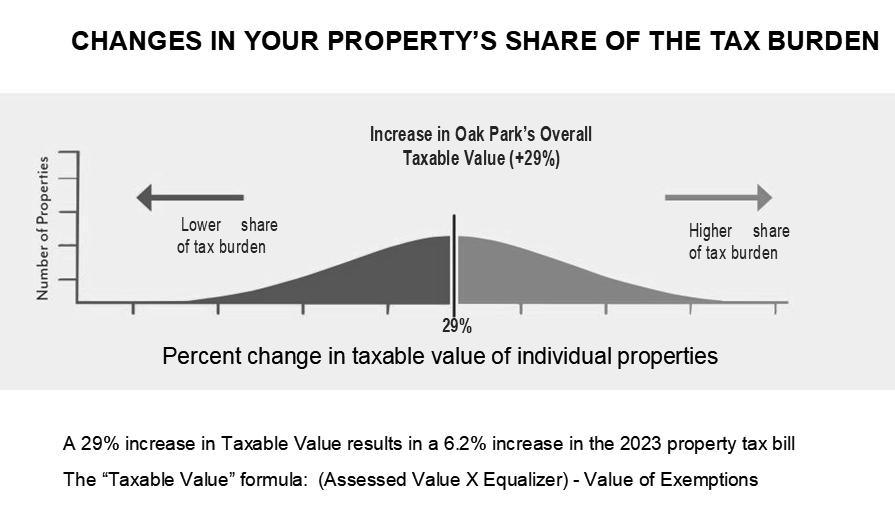
I thought Illinois law limited tax increases for local governments to the annual rate of inflation, which is 3.3% right now. How could Oak Park spending go up by 6.2%?
T he tax cap law limits most local gove r nments from increasing their tax levies by either the rate of inflation or

5%, wh icheve r is lowe r. This year, the applicable rate of inflation is from the year 2022. Since 2022’s inflation rate was ab ove 5%, the tax increases for Oak Pa rk ’s public schools, pa rk district and township we re capped at about 5%.
Oak Pa rk ’s village gove r nment and l ibrary are both exempt from tax caps, but they used thei r exempt status differently. Vi llage gove r nment’s 3% levy increase is the smallest among Oak Pa rk ’s local gove rnments, whereas the library’s 8% increase is the biggest.

Finally, Oak Pa rk ’s share of re gional gove rnment tax levie s increased sign ificantly. This is because Oak Pa rk proper ty values rose due to reassessment wh i le the values of non-reassessed areas in the re gion remained unchanged
Can I do anything to reduce my current tax bill?
If you are eligible for a homeowner, senior citizen or disability exemption but did not receive one, the Township Assessor’s Office can assist you in obtaining a revised bill for a smaller amount. If you received all exemptions for which you are eligible, however, you likely will not be able to reduce your current tax bill.
If you purchased and moved into your property in 2022, you should pay special attention to the homeowner exemption, as you had to apply for the exemption earlier this year to receive it on the tax bill. The Township can help if the exemption is not on the bill.
Can I do anything to reduce future tax bills?
On July 8, the Cook County Board of Review began accepting 2024 assessment appeals. Oak Park residents should be able to file appeals until sometime in August, although the exact deadline has not yet been announced.
For those struggling with unexpectedly higher property tax bills stemming from the reassessment, the best way to find relief may be to file an assessment appeal. A 2024 appeal will not reduce this year’s taxes, but if successful, it should provide some relief on next year’s second installment bills.

Gysbert Lee Menninga, 90, died peacefully in his sleep on June 30, 2024, a little over a year after the death of his wife, Sylvia. The seventh of 10 children, he was born on a farm outside Otley, Iowa on April 25, 1934. High school sweethearts, Gy and Sylvia married in 1955 while he was studying for his engineering degree, first at Calvin College in Grand Rapids then finishing up at the University of Michigan in Ann Arbor. In 1957, he was drafted into the ar my and the couple moved to El Paso, Texas for two years where their first child, Elizabeth, was born. Moving back to Michigan, he started his first professional job, at Michigan Bell in Detroit. The Bell System assigned him to work at the prestigious Bell Labs in New Jersey, their R&D center, for a year.
In 1969, the family moved to Highland Park in suburban Chicago when Gy accepted a job as an engineer at Cook Electric. Two years later, together with a colleague, he started his own company, CEAC, to sell his patented surge protectors to telecoms and transportation systems. In the mid’70s, he sold the patent to Joslyn Electronic Systems and worked for them as a salesman. He finished his career as interim CEO for two of Joslyn’s subsidiary compa-
nies, first in Burlington, Ver mont, then in Boulder, Colorado, where his mandate was to oversee the companies’ reorganizations.
He retired with Sylvia in Oak Park to be near and help raise grandchildren. Although officially retired, he never slowed down. He started his own fix-it business in his 60s, providing simple repairs and odd jobs at a low cost to a wide range of clients, many of them elderly. An active member of First United Church of Oak Park, he also volunteered with a wide range of humanitarian and progressive causes, from housing and hunger to LGBTQ rights and prison reform. He served as supervisor for the construction of two Habitat for Humanity houses; helped with reconstruction following Hurricane Katrina in Louisiana; co-coordinated the Crop Hunger Walk, with Sylvia, for many years; co-founded and co-facilitated the Oak Park chapter of PFLAG (also with Sylvia); lobbied for LGBTQ rights in Springfield and protested U.S. paramilitary involvement at the Western Hemisphere Institute for Security Cooperation in Georgia.
He and Sylvia were recognized for their community service with the Ulyssean Award from the Senior Citizens Center of OP-RF, and the Bruce Scott “Courage and Justice” Award recognizing LGBTQ activism. His contributions to community, like his parenting, were always accomplished with thoughtful patience and kindness
Predeceased by his son-in-law Chris Leroux, Gy is survived by his children, Beth, Bert (Francisco Ballesteros), Nick (Nancy Fong) and Charles; his grandchildren, Alizarin, Thalo and Haskell Menninga; Isabelle (Mauss) Leroux-Jones; and Owen Boone; his brothers, Clarence Menninga and Larry (Mary Jo) Menninga; his sister, Phyllis (Ray) Klapwyk; and many nieces, nephews, inlaws and dear friends.
In lieu of flowers, donations should be sent to Proviso Habitat for Humanity at P.O. Box 6544, Broadview, IL 60155.
A memorial service will be held at 2 p.m. on Saturday, Sept. 7, 2024, at First United Church of Oak Park, 848 Lake St., Oak Park, IL 60301.
Arrangements were handled by Zimmerman-Harnett Funeral Home in Forest Park
Realtor, traveler, volunteer
officer with Prairie Title. After thei r last child gr aduated from high school in 1990, they p ulled up roots and went back to Sioux Falls. T heir final move was to a newly built home on a lake in Pe q uot La kes, Minnesota, in 2000.


Diane Carolyn (Johnson) Eitrheim received her invitation to the Heavenly Homecoming Party on Sunday, June 16, 2024. Born in Hamburg, Iowa, on April 21, 1935 (Easter Sunday) to parents Walt and Nola (Eleanora) Johnson, she was a star basketball player in high school and a beauty queen, winning the coveted title of Queen of the Popcorn Festival. In 1955, she was the runner-up for Miss SW Iowa. She attended Augustana College in Sioux Falls, South Dakota, graduating with a degree in Music Education. In 1958, she married her college sweetheart, Jim Eitrheim. They moved to Oak Park in 1959 where they live d for 31 year s.
Diane sold real estate with seve ra l agencie s, beginning in 1978. Pe r sonable, friendly, and easy-going, she was rewarded for her ef fort s, earning a spot in the prestigious Million Dollar C lub. After 10 years of S und ay open houses and wo rk ing to “close the d eal,” she turned in her realtor badge and became a title
A student of the world she traveled to many locales throughout her 89 years. Over their 52 years of mar riage, she and Jim lived in three states and joined three churches, singing in the chancel choir for each of them. T heir friends were life-timers, who attended her annual Lefse Party, a hot ticket at holiday time. She was a lifelong member of the P.E.O. Sisterhood, for whom she served several stints as president. She was also president of the cong re gation at United Lutheran Church in Oak Park. She was never afraid of saying ‘Yes’ and did so often. She left people feeling uplifted with her radiant smile, sense of humor, and sparkling personality.
Diane is survive d by her three children, Kristofer Eitrheim, Karin (Steve ) Maas, and Erik (Dawn) Eitrheim, and her gr andchildren, Greta Maas, Ingrid Maas, A lec Eitrheim, Erik Maas, and Av a Eitrheim.
A gathering will take place on Aug. 3 at Lutheran Church of the Cross in Nisswa Minnesota to celebrate her life. Visitation will begin at 10 a.m. with the service at 11 and committal in the Memorial Garden at noon. A luncheon will follow at the church Memorials may be given to:
OPRF High School OPUS Scholarship Fund online: oprf.iphiview.com/oprf/Donate, c/o the OPRF Community Foundation, 1049 Lake St., Suite 204, Oak Park, IL 60301 or United Lutheran Church, 409 Greenfield, Oak Park, IL 60302.



Legal Notice State of Illinois County of Cook PUBLIC NOTICE ID HEREBY GIVEN that a public hearing on the adoption of the proposed Annual Budget and Appropriations Ordinance of the Park District of Forest Park, County of Cook, Illinois for the fiscal year beginning May 1, 2024 and ending April 30, 2025 will be held at the Administration Building, 7501 Harrison Street, Forest Park, IL 60130 on July 18, 2024 at 6:00 p.m.
Jackie Iovinelli Park District Board Secretary
Dated this July 8, 2024
Published in Forest Park Review July 10, 2024
PUBLIC NOTICE STATE OF ILLINOIS COUNTY OF COOK VILLAGE OF FOREST PARK
I, VANESSA BELMONTE, CLERK OF THE VILLAGE OF FOREST PARK, DO HEREBY STATE, that on Monday, July 22, 2024, at 6:45 PM at the Forest Park Village Hall, 517 Desplaines Avenue, Forest Park, Illinois, a public hearing will be held to consider the proposed adoption of the Appropriation Ordinance for fiscal year 2024-2025 for the Village of Forest Park. At the public hearing, all interested persons may provide comments concerning the appropriation of the sums of money the Village of Forest Park deems necessary to defray all its necessary expenses and liabilities. The appropriation document will be available for public inspection no later than July 12, 2024, in the Village Clerk’s Office at the Village of Forest Park, 517 DesPlaines Ave., Forest Park, Illinois.
Dated this 10th day of July, 2024
Vanessa Belmonte Clerk, Village of Forest Park
Published in Forest Park Review July 10, 2024

PUBLIC NOTICE STATE OF ILLINOIS VILLAGE OF BROOKFIELD
Notice of Public Hearing Village of Brookfield Planning and Zoning Commission July 25, 2024, at 7:00 PM
NOTICE is hereby given that the Village of Brookfield Planning and Zoning Commission will conduct a public hearing on Thursday, July 25th , 2024 at 7:00 p.m. in the Edward Barcal Hall located at 8820 Brookfield Avenue, Brookfield, Illinois for the purpose of considering a request from Ben Thurnhoffer for a variation from §62-75 Bulk, yard and space requirements in order to build an enclosed porch for property located at 3132 Park Avenue, Brookfield, Illinois 60513 (PIN 15342010460000).
Legal Description: THE SOUTH 50 FEET OF LOT 12 IN BLOCK 6 IN BROOKFIELD MANOR, BEING A SUBDIVISION OF THE NORTHEAST QUARTER OF SECTION 34, TOWNSHIP 39 NORTH, RANGE 12, EAST OF THE THIRD PRINCIPAL MERIDIAN, (EXCEPT RAILROAD RIGHT OF WAY OF SUBURBAN RAILROAD), IN COOK COUNTY, ILLINOIS.
The public is invited to attend the public hearing and present oral and/ or written comments. Written comments may be provided prior to 4:00 PM on the day of the public hearing to: Village of Brookfield, Planning and Zoning Commission c/o Kate Portillo, 8820 Brookfield Avenue, Brookfield, IL 60513, kportillo@brookfieldil.gov, or 708-485-1445. Oral or written testimony may be given during the public hearing.
The application may be viewed at the Village of Brookfield Village Hall during normal business hours. Please reference PZC Case 24-13. Public hearings may be continued from time to time without further notice except as otherwise required under the Illinois Open Meetings Act.
Individuals with disabilities requiring a reasonable accommodation in order to participate in any meeting should contact the Village of Brookfield (708) 485-7344 prior to the meeting. Wheelchair access is available through the front (South) entrance of Village Hall.
By the Order of Chuck Grund, Planning and Zoning Commission Chairman.
Published in RB Landmark July 10, 2024

NOTICE OF PUBLIC HEARING
You are hereby notified that a Public Hearing has been called by the Housing Authority of the Village of Oak Park, Oak Park, Illinois to be held at the Village Hall of Oak Park at 123 Madison Street, (Lombard and Madison), Oak Park, Illinois in Room 201 at 10:00 A.M. on Wednesday, August 28, 2024, for the purpose of considering the following item of business:
To hear comments from the Public on the Public Housing Agency Plan.
The draft of the PHA Annual Plan for 2025 along with the public’s comments will be considered by the Authority before adoption of the Annual Plan to be submitted by Tuesday, October 15, 2024, to the U.S. Department of Housing and Urban Development.
The draft plan is available for inspection at the following locations during normal hours of operation, Monday through Friday, 8:30 A.M. to 5:00 P.M.:
Oak Park Housing Authority
21 South Boulevard Oak Park, IL 60302
Mills Park Tower 1025 Pleasant Place Oak Park, IL 60302
Written comments will also be accepted prior to the hearing for inclusion in the public record. Address all comments or inquiries to: Oak Park Housing Authority Executive Director Re: PHA Annual Plan 2025 21 South Boulevard Oak Park, IL 60302
Published in Wednesday Journal July 10, 2024





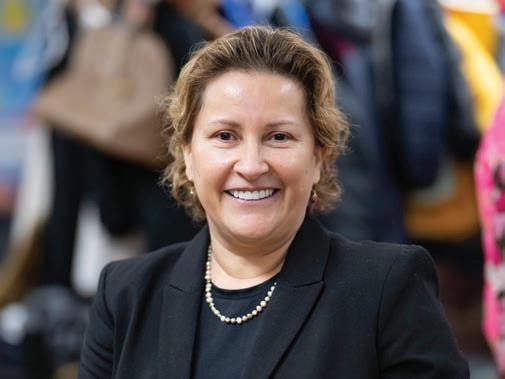

Since the Great Migration, the West Side has welcomed thousands of Black Americans searching for a new place to call home
By DELANEY NELSON and FRANCIA GARCIA HERNANDEZ Special Projects Reporters
For generations, West Side families have called home communities like Garfield Park, North Lawndale, and Austin. In this series, we talk to longtime West Side residents about the meaning of living, owning, and staying on the West Side.
Felicia Oliver has lived with her family in Austin for around 40 years. In her Austin home, near the intersection of North Menard Avenue and West Washington Boulevard, Oliver said she and her husband created a safe, thriving and strong place for opportunity, for her family and for the community
Aisha Oliver, Felicia’s first-born daughter, said she remembers moving into the house in 8th grade. Oliver is also an occasional columnist for Austin Weekly News. Some of her core memories were made within the home’s walls, on the front porch and in the backyard, where family, friends and neighbors continue to gather.
In many ways, Aisha said, that home shaped who she is and how she shows up for the community. She still lives in Austin, just a walk away from her family home.
In an interview with Austin Weekly News, Aisha and Felicia Oliver shared the hurdles and value of owning a home in Austin, and, perhaps more importantly, what the significance means for the family.
The interview has been edited for clarity and length.
AWN: How did you find this home?
Felicia: When we started our homeownership process, we were living in my aunt’s building [on the West Side]. It was a family building. They were getting older and we wanted to give
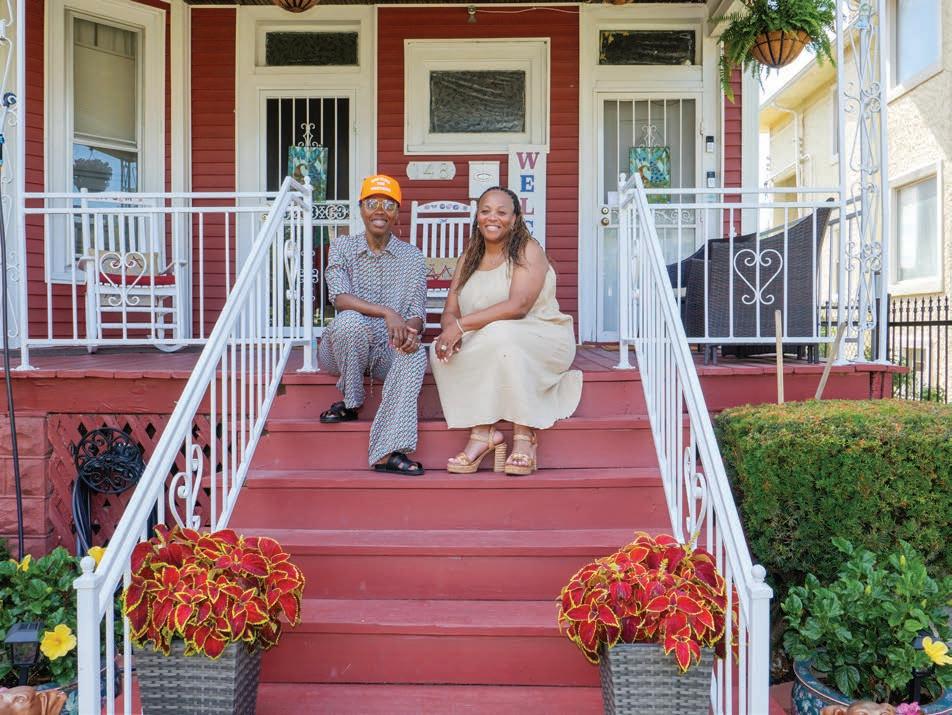
them a home — I think that’s everyone’s dream, or at least, I think it’s most Americans’ dream to have home ownership. So we started this process.
We found a realtor and we had only looked at three houses, literally. I remember when we went to see the homes, this was the last one. And I remember walking through, and, you know how you just know when something is it? We were like, “OK this is it.” It had enough space.
One of the things that we knew was that we wanted to give our kids somewhere to call their own. So we came from LeClaire Courts in the projects, left there, and went to my aunt’s building, and from there, to our own home, and we’ve been here ever since.
AWN: What was it like moving into this home in 8th grade?
Aisha: I am the oldest of all my siblings. So, I was old enough to know what was going on. We’re really family-oriented, so we’ve always been around our relatives in some capacity. Even when we lived in the projects, the rest of my family lived two blocks away, so our entire family was in one neighborhood, one community. I never felt like we were being taken out of space and thrown into something new, because I knew wherever I went, my family was close by. We moved into a space where it was community
See HOME on page B2
Continued from page B1
Moving into the house, it was exciting as a kid, because now we’re in this space that’s totally ours. We’re coming from my brother and I sharing rooms, we were bunk-bed kids, those are core memories for us. At night, you get to talk to your brother about everything he did during the day. Going into the house, immediately my brother was like, “I’ll take in the whole attic, that’s my room.” My mother did my sister’s room in pink and purple, super girly.
My father immediately jumped into maintaining the property. I mean, grass cutting, hedges cut. Maintaining it is very much generational, because we understand what it took to get the homes and how family helped family
That transition was really a core memory for me because I know what it took for my parents to get that house for us. I saw my mom stressing. I probably never told her, but I saw how they were really pulling strings to get through the home-buying process. Kids listen when you think they’re not listening. Sometimes, my mom would cry because they would be so close and then felt like they hit a brick wall.
But, in my opinion, it was bigger than the house. My parents are extremely passionate about giving us what they didn’t have. So, in my mind, it was like hell or high water, they were giving us that house, that home. And it was bigger than that because as soon as my parents got the house, not only do we get our space — our cousins were there every weekend, our friends wer there every weekend. My parents are the all-thekids-want-to-go-to-their-house type of family
I know it’s generational because my son told me two days ago that he wants to be the grandfather that has the big house and all his grandkids want to come there — because that’s what he knows of his grandpa. That’s what he saw his grandfather do.

AWN: How does home ownership shape West Side families and their history in the neighborhood?
Aisha: I’ve been organizing since I was 19. Watching my parents buy their first home, and once we got in the house, really made me think about my great-grandmother. At one point, our whole family lived in that one house when I was a little kid. You had close to about 20 people living in this one space—my great-grandparents, my grandparents, great-aunts and uncles, my mom, her sisters, and her cousins. And then they started having kids, us.
As I got older, I realized my grandmother came here from Mississippi at age 17. They lived in the projects, moved to other projects, and then bought their first home. They raised their family in the home that she still lives in, to this day. So a lot of my organizing is really empowered behind the struggles that I’ve seen in my own family, but I also recognize that there is a lack of education in Black communities. It’s truly structural if we’re being completely honest – it’s very much structural and economic. I think about the things that I saw them go through silently and it made me go do things so that I wouldn’t have to go through the same thing.

It was a confirmation of being raised in love. My parents had [me] at 16. They had us really young. As the firstborn, I pay close attention to how much compassion and effort my parents put into making sure that they can give their children what they didn’t have and then turned around and gave it to their grandchildren the same way They are the epitome of the born-and-bredand-raised on the West Side. They are the epitome of wanting to continue that legacy by passing it on to their children first and teaching us, showing us how to do it — and then opening up that space so that not only do we get the experience of growing up in the home, but all of our friends who were still living in the projects could come to our house and be able to stay there for three or four days — that was life-changing for them.
AWN: What are some challenges you faced during your homeownership journey, and what tips do you have for prospective home buyers?
Felicia: The first tip I would really recommend, knowing what I know now and actually living through it is, making sure that you save — and not just for the home. The upkeep of the home when things break, when things happen, you can’t call your landlord. You are the landlord. You have to have money set aside for incidentals. We learned that the hard way. We came out of an apartment into a home — my parents didn’t have a home. As [Aisha] was saying, each generation wants to see the next generation do better. But the
backlash of that is when you don’t have the education to do so. You want to do better than your parents, but if there is no one to educate you on the process, that makes it harder, even though you might have saved the money and you might have gotten the home. When you need things done around the house, you have to do all those things yourself because you’re the owner. We ended up learning that, but it took a while. We didn’t have the know-how, we just knew we had this huge home.
So I will tell people [to] not only plan for the purchase, but make sure you put money aside every pay period, or however you want to do it. Get on a budget. Budgeting is key, that way you don’t feel as overwhelmed.
Make sure you take a homeowner’s class. Make sure you are financially prepared for the down payment and for what comes after the down payment. After you move in, make sur you are prepared, place yourself in some organized groups where you are constantly educating yourself about this process, even after the process, after the closing. You want to make sure you stay connected to others that could give you wise counsel. The whole housing process is so overwhelming. I’ve seen so many people lose their homes for not knowing that they have to pay the property taxes, and you could end up losing your home for pennies on the dollar. So just making sure that you know all of what it entails, and not just going and thinking, “Oh, I got this house.” There’s a lot that comes with homeownership
AWN: What can West Side families do to ensure they can own or preserve a home in the community they have long called home?
Aisha: I haven’t bought a property, but I take a free homebuyers class every so often. I’ve been certified by Neighborhood Housing Services twice. I was taking classes when I was in my 20s just because I knew how hard it was for my parents, and I always aspired to have a home in this community I’ve taken the classes at least three times, even though at those times, I was nowhere near ready to purchase a home.
AWN: Why is seeking homebuyers’ education a priority for any West Side neighbor who wants to own a home?
Aisha: I come from a family that prioritizes education because they [my parents] were not

No matter the reason a homeowner pursues home renovations, knowing what to expect will ensure their home ownership experience is successful, according to West Side realtor Shantel Franklin.
In Chicago, 43% of renovating homeowners went over their renovation budgets in 2023, according to data provided to Austin Weekly News by Houzz. The main reason renovating homeowners exceeded their budgets was unanticipated costs. In 2022, home improvement project spending increased to $472 billion, up from $328 billion in 2019, according to the Joint Center for Housing Centers of Harvard University
Before you start renovating, West Side-based realtor Shantel Franklin advises you to take a look at the costs — including the ones you might not expect. Knowing your budget and timeline is key to preventing a home renovation from becoming a nightmare.
“A realtor is definitely going to help you find a
able to go to college, they were not able to do certain things. You know what I mean? They were teenage parents. But, I know there are answers out there because my greatgrandparents had less education than they did, but they bought a home and raised generations in it.
It’s about making that a priority because that’s not something that is just passed on. It’s not like they’re teaching financial literacy, homebuyers’ education and taxes in schools. We have to really understand that a lot of that education is not a fair game and no one’s gonna come in and teach it to us. It has to be a responsibility to make education a priority and pass that on so we don’t have to continue to struggle, finding out the hard way and learning the hard way.
Felicia: I am especially focused on financial literacy in this community for that reason. In order to sustain even just paying your rent and preparing you for homeownership, you need a level of financial literacy. I feel a strong pull, now more than ever, to teach it at a younger age — we should be teaching kids how money works, how to create a small budget and how to invest.


home or a property in general that you will want to rehab, but (they’re) going to rely heavily on the buyer in terms of knowing their numbers, what they’re trying to do, their capacity to do it and their timeline,” Franklin said
AWN: From your perspective, why is owning and keeping a home vital to preserving West Side culture and community?
Aisha: When longtime homeowners pass and there’s nobody to take up the responsibility, these homes are going to be sold to somebody who doesn’t understand not just the value of that home, but the value of the community that the home is in. That’s the key
When they sold and repainted the pink house on North Central Avenue, that was heartbreaking for people who lived in this community. You have no clue what that home meant not only to the family that lived there but, to the families that grew up around it. It signified you were in Austin; you knew you were on the West Side.
Felicia: We should have more people saving their families’ homes. Their grandparents worked hard coming from the south to the north and planting [roots] in this city. I have so many friends and neighbors who lost their parents’ home and grandparents’ homes because they didn’t have the tools and the right information — not because they didn’t want it, but because they were devoid of knowledge.
Austin is already transitioning, and my con-


cern is that many will lose their homes. Many will sell without understanding what they have in their hands. Austin is historically a beautiful and strong community, but it’s shifting. When
you know the backstory to something that your family worked hard for, it fuels you to say, “No, I’m gonna keep it and do whatever I can do to keep what we have in our bloodline.”
By DELANEY NELSON Special Projects Reporter
Around 400 people attended Spanish Coalition for Housing’s annual “Camino a Su Casa” homeownership exposition, which connected
prospective homebuyers with housing counselors, banks, real estate agents and government officials.
The event provided free credit checks to the first 60 attendees, and hosted homebuyer workshops and over 30 exhibitors.



